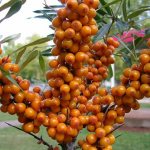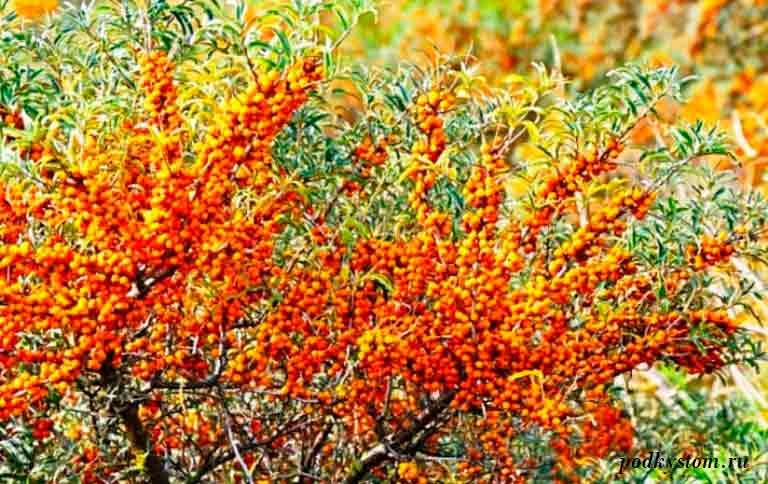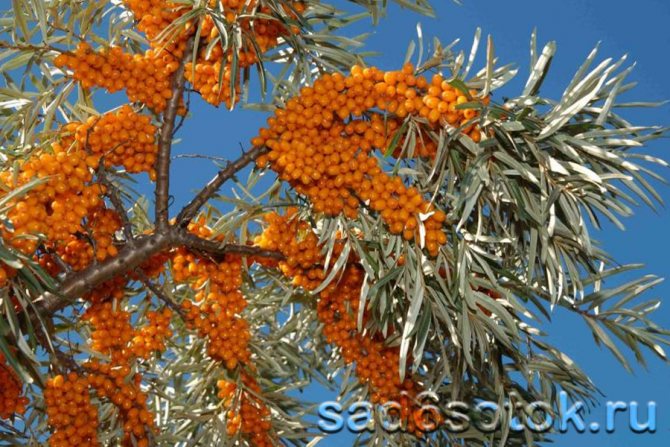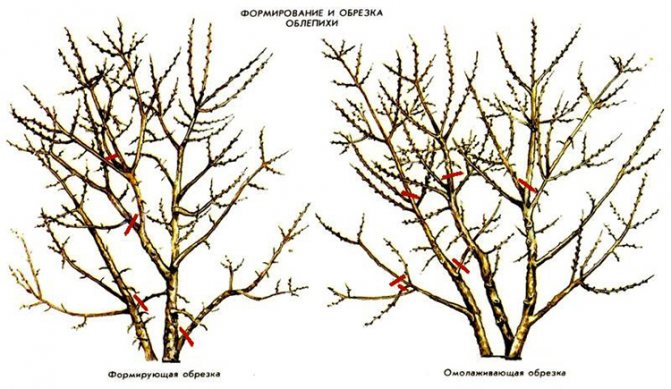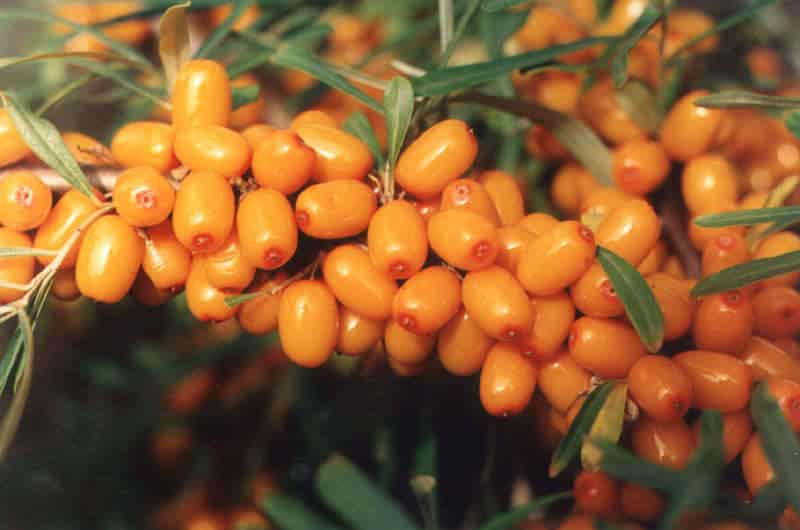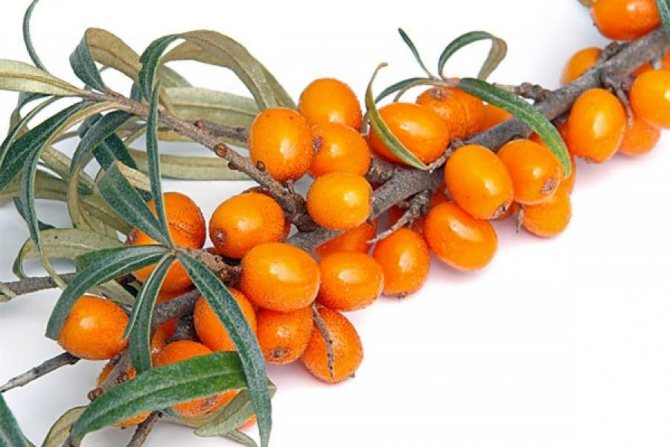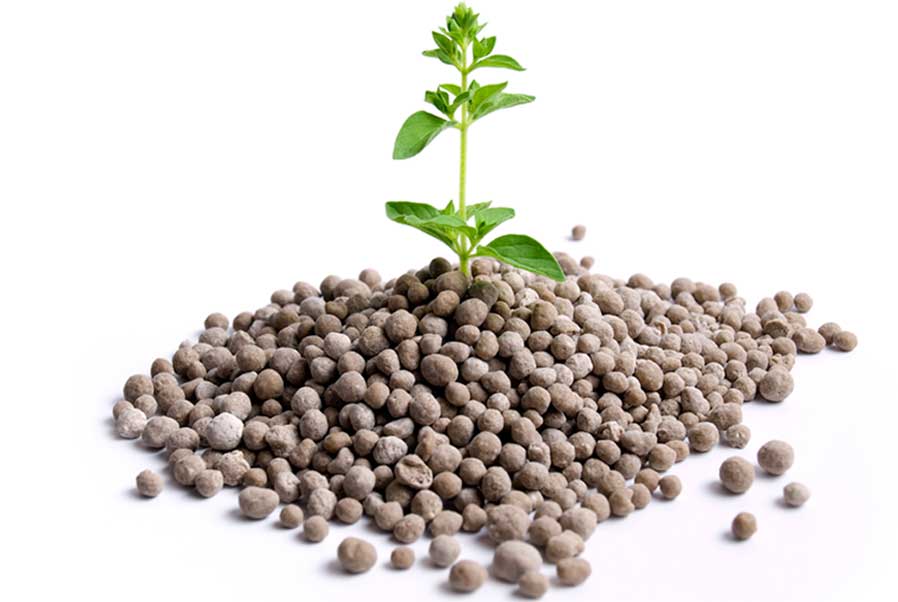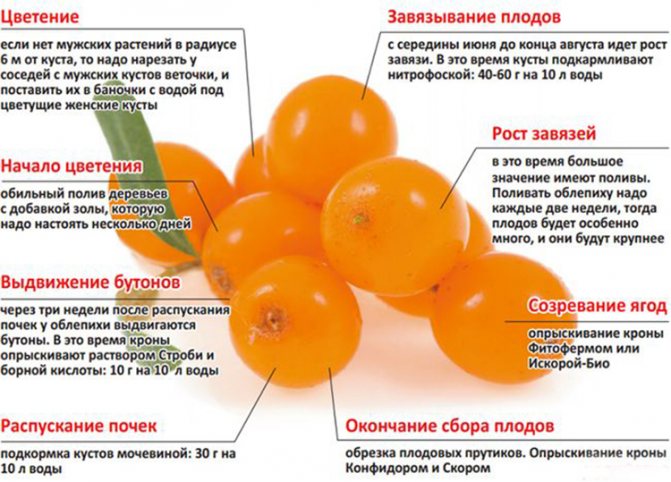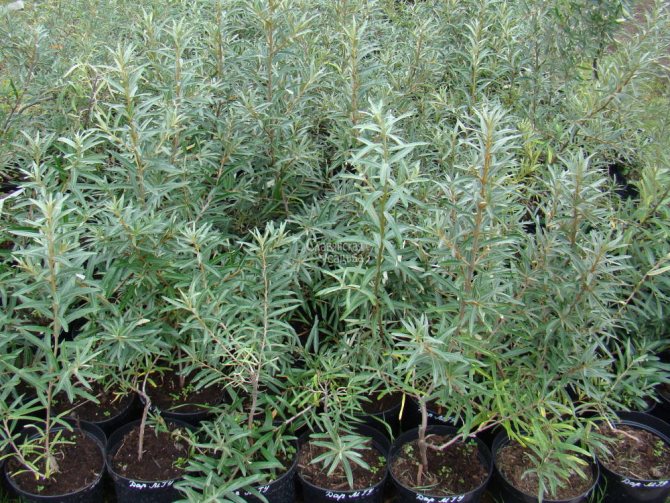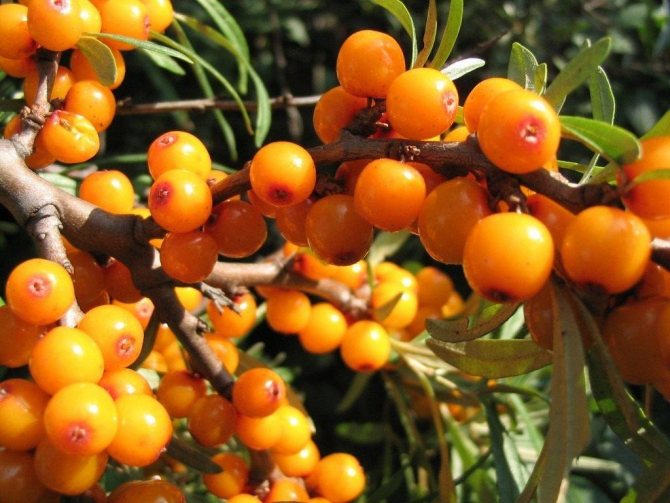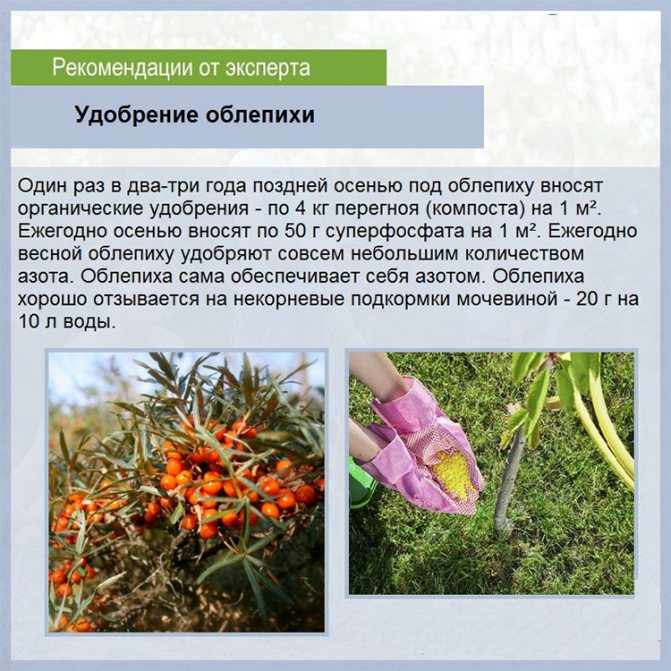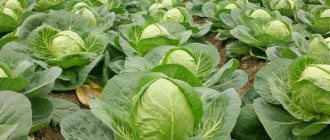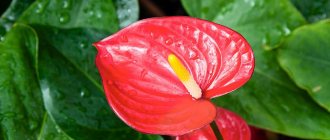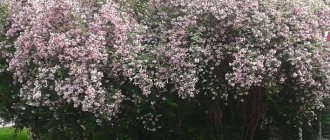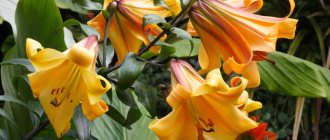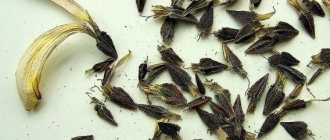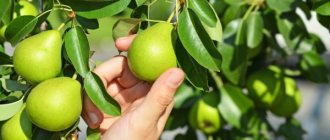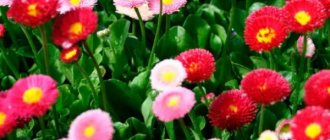Home »Garden and vegetable garden» Health Garden
Sea BuckthornHealth Garden
Vladimir Serchenko
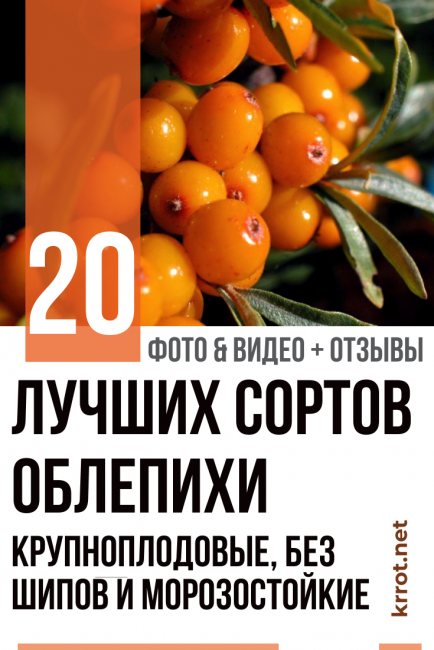
Sea buckthorn
Sea buckthorn is considered one of the most useful plants, its fruits contain a huge amount of useful substances that have a beneficial effect on the entire human body. Now sea buckthorn, the description of the varieties of which can take a very long time, is widespread throughout the globe, it can be found in the regions most remote from Siberia.
- General information
- Varieties
- Large-fruited varieties
- Openwork
- Augustine
- Elizabeth
- Essel
- Thornless varieties
- Giant
- Sunny
- Altai
- Friend
- High-yield varieties
- Botanical
- Abundant
- Moscow beauty
- Chuiskaya
- Beloved
- Nivelena
- Frost-resistant varieties
- Ear of gold
- Trofimovskaya
- Gift of Katun
- Excellent
- Surprise Baltic
- Siberian blush
The principles of growing and caring for sea buckthorn
Features of growing and care:
- Pair landing. The main feature of sea buckthorn is dioeciousness. Alone, sea buckthorn is not planted if they want to get berries. Fruiting sea buckthorn is a beautiful sight and a real decoration of the garden.
- More female plants. There is no need to plant a male for every female plant. Each bush with male flowers is capable of pollinating up to 5 female flowers. Male plants die more often than female ones; for safety reasons, it is better to plant more of them.
- Pollination direction. Sea buckthorn is a wind-pollinated crop, so its direction must be taken into account.
- Careful loosening. The sea buckthorn root system is located close to the surface of the earth. When digging and loosening the soil, this must be taken into account.
- After each watering - loosening. Due to the peculiarities of the sea buckthorn root system, the soil in its near-stem circle must always be loosened.
Nuances of agricultural technology in various regions of Russia
The shrub grows well and bears fruit in various regions of Russia. But when planting modern varieties, it is recommended to choose those that are bred for a specific region. Then the gardener will always get a bountiful harvest.
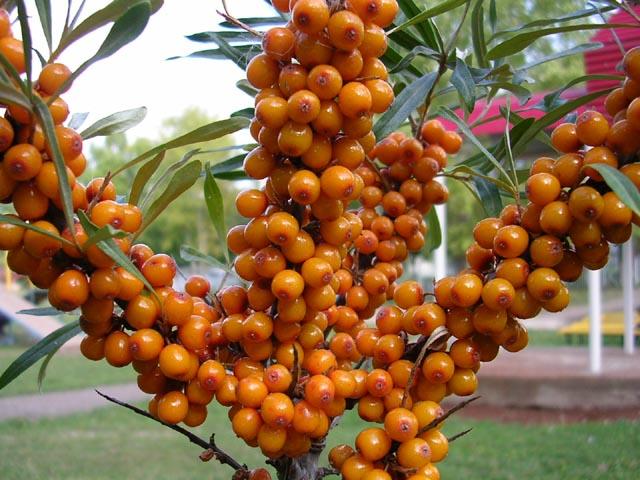

Moscow suburbs
Gardeners began to massively grow sea buckthorn in the Moscow region in the 70s of the last century. There was no talk of varieties, the usual buckthorn grew everywhere. The climate and soils of the region are suitable for the cultivation of sea buckthorn. Now breeders have created more than 60 varieties that are included in the State Register and are recommended for cultivation in the region.
Urals and Siberia
In the Urals and Siberia, there are thickets of wild sea buckthorn, so local gardeners prefer to pick wild berries, rather than plant plants on the site. But breeders have created new varieties, their characteristics are better than those of wild ones. Gardeners place such shrubs in the country. When planting several cultivated seedlings, girls, it is permissible to have a wild boy for pollination.
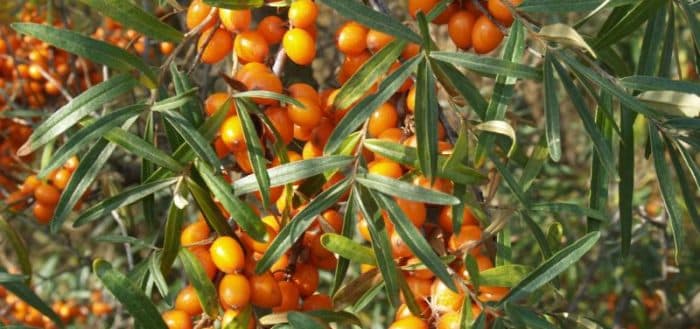

When planting varietal sea buckthorn, you should choose the species zoned for Siberia or the Urals. Such a shrub will easily endure winters with low temperatures and strong winds. The cultivated sea buckthorn growing in the Urals and Siberia should be looked after according to the usual rules.
How to distinguish male from female sea buckthorn?
It is possible to distinguish the "sex" of the sea buckthorn bushes / trees growing on the site only after the first flower buds appear. This can be done only at 4-5 years of age.
Signs by which you can distinguish a female from a male:
- Female plants have smaller buds and fewer of them than male shrubs.
- Male buds are collected in spike-shaped inflorescences.
- In male plants, leaf plates are flat, in female plants, they are curved, cupped.
- Female flowers are yellowish in color, collected in inflorescences. Gentlemen are greenish-silvery.
- In male plants, the crown is bluish in late spring, in female plants it is bright green.
At the stage of seedlings, it is very difficult to distinguish between male and female plants, but it is possible - by the size of the buds (male are larger) and by the color of the leaves.
Planting sea buckthorn
Experienced gardeners recommend planting sea buckthorn in the spring, which will allow the plant to grow stronger before the onset of cold weather.
Planting dates for sea buckthorn
The best period for planting crops in spring is the last decade of March or the first days of April. At this time, there is a sufficient amount of moisture in the soil, moreover, the shrub is dormant. A seedling in a special pot or container can be planted in a permanent place in the fall. In this case, the planting dates are shifted from the last decade of September to mid-October. In any case, work must be carried out when daytime temperatures drop to +4 degrees.
In the autumn, plant the crop after the leaves have fallen, then the seedling will spend all the nutrients not for vegetation, but for rooting in new soil.
If the planting dates were missed for any reason, then it is necessary to dig young plants into the ground before the start of the new season. So they will overwinter and remain viable until the next transplant. The highest area in the garden is used to shelter the seedlings. In the garden, you need to make a groove about 60 centimeters deep and put the bushes there. During such work, the crown of the tree must be oriented to the south, which will prevent sunburn of the crown. Next, the hole with the seedlings is sprinkled with soil, tamped and watered with warm water.
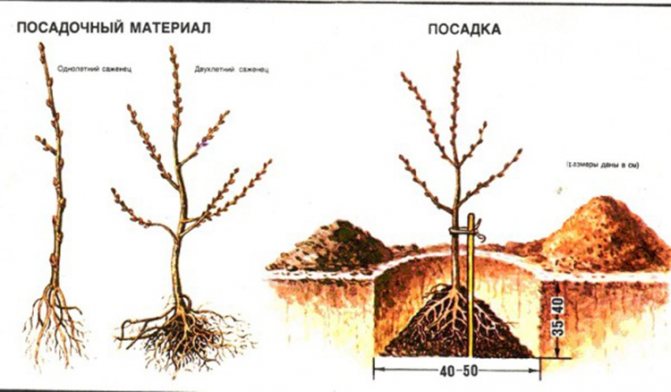

After a significant cold snap, the plants are completely covered with a layer of earth. To protect against rodents, sea buckthorn is covered with a thick layer of spruce branches. The snow accumulated at the beginning of winter is compacted, which will create additional protection for the plants.
The advantages of spring planting of sea buckthorn are:
- the possibility of collecting an earlier harvest;
- rapid development of the root system of the plant, which reduces the risk of death of young seedlings;
- you can identify lagging plants and provide them with additional care in the form of watering.
One of the disadvantages of spring planting of sea buckthorn is the impossibility of accurately calculating the period of sap flow, as well as a limited choice of varieties of seedlings. You need to take care of trees during this period more carefully, because they can suffer from the effects of prolonged drought.


The advantages of autumn planting can be considered:
- Huge selection of planting material. Product quality can be visually assessed by the development of foliage and root system. Some sellers for advertising give to try the fruits of the sea buckthorn variety being sold.
- Significant reduction in the value of trees.
- Simplified sea buckthorn care.
- Trees planted in autumn develop much faster than spring saplings.
The disadvantages of planting sea buckthorn in autumn is the possibility of damage to the plant from frost and strong winds. In winter, the bark of the crop can be damaged by rodents or other pests.
Pollination of sea buckthorn
As we said, sea buckthorn bushes have male and female inflorescences. To get good yields of berries, it is enough to plant these two plants in close proximity to each other (10 meters of distance will be enough). For better pollination and fruiting, gardening experts recommend planting one female between two males.This is due to the fact that male plants are more likely to die, and planting two such trees in the neighborhood will only increase the chances of a good harvest.
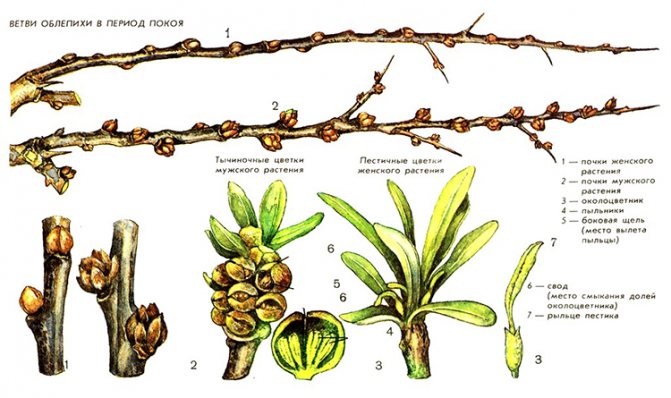

Sapling selection
The choice of planting material should be carried out according to the following rules:
Plants must be healthy and of the variety indicated by the seller. The height of a standard two-year-old seedling is within 50 centimeters, the trunk diameter is 5-7 mm. The plant has up to 8 main roots, about 25 centimeters in size.
In a healthy seedling, the bark should fit snugly against the wood. Areas with wrinkled or scratched coverings are not allowed.
Some gardeners have difficulty identifying male and female trees. Immediately, we note that there is a difference between such seedlings and, moreover, significant. So, on the shoots of the female sea buckthorn, there are small double buds. On male plants, they are large, covered with additional protective scales. The leaves of the first species are standard green. The leaf blades of male seedlings are usually gray-gray with a characteristic bloom.
Landing patterns
Sea buckthorn loves sunlight, and a sufficient amount of moisture in the soil, therefore, the specified tree should be planted in areas well-lit by the sun, away from tall horticultural crops. If you do not comply with this requirement and allow the bush to overgrow with weeds, then it may die in the very first year of cultivation from a lack of light.
Particular attention should be paid to the choice of soil. Sea buckthorn will grow best in soils saturated with moisture, for example, on sandy loam or loam. Such soil retains moisture for a long time, prevents its evaporation. The planting site should be slightly overstated, since the culture does not tolerate stagnant groundwater.
Landing holes for sea buckthorn are dug in the form of a cube with a side of 60 centimeters. At the bottom of such a pit, a drainage layer of broken brick or expanded clay is poured. Its thickness should be between 10 and 15 centimeters. Next, they make a mound and set the seedling in a strictly vertical position, carefully straighten its root system and sprinkle it with soil.
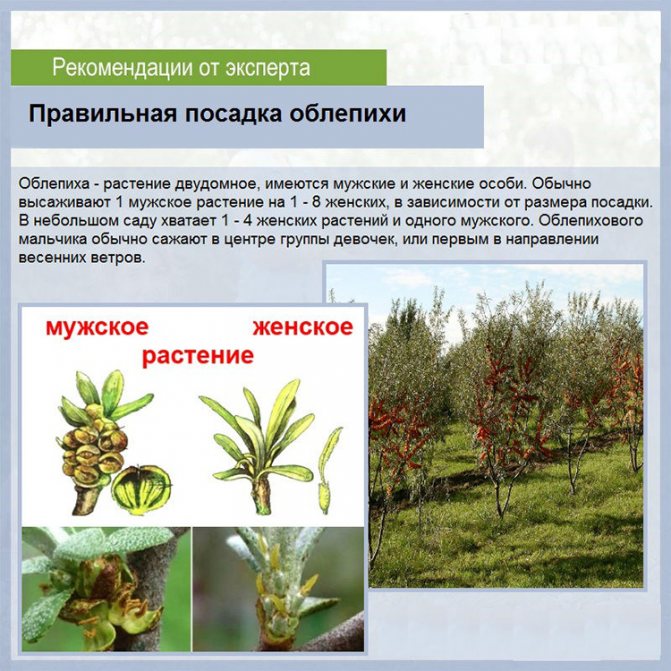

Use a mixture of regular garden soil and sand in equal proportions as soil, plus a small amount of any organic fertilizer.
During planting, the root collar of the culture is oriented to the east and buried in the soil by 3-5 centimeters. Now you need to make a small depression around the base hole and pour two buckets of warm water here. To prevent evaporation, the soil is mulched with chopped straw or sawdust.
When planting sea buckthorn bushes, you need to remember the planting scheme, that is, alternate female cultures with male ones. The plants in question do not grow much, therefore a minimum distance of 2.5 meters is left between them. It is recommended to plant male trees on the leeward side, followed by several female bushes. Such a planting scheme will contribute to better wind pollination of crops.
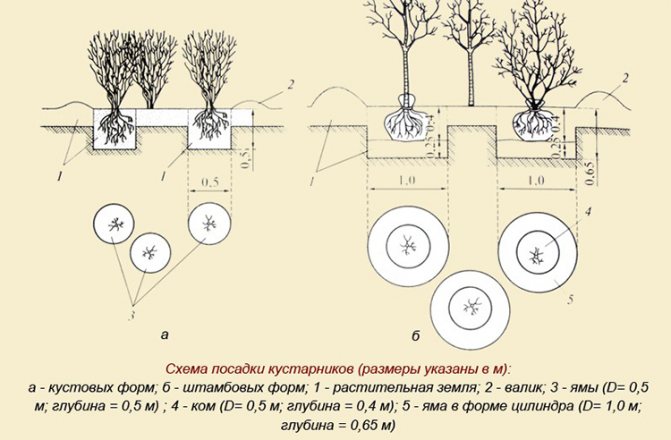

Recommended varieties
Among the sea buckthorn there are varieties:
- Sweet. Sea buckthorn berries have always been sour, but today varieties with fruits of increased sweetness have been bred - Lyubimaya, Ruet, Tenga, Moskvichka, Nizhny Novgorod sweet, Moscow pineapple, Klavdia.
- No thorns. Without thorns, harvesting is greatly simplified. Popular shipless varieties are Solnechnaya, Zhivko, Socratovskaya, Giant, Podruga, Altai, Excellent, Chechek.
- Large-fruited. Sea buckthorn is covered with small berries. If the culture is planted in order to obtain berries, it is advisable to plant large-fruited varieties - Elizaveta, Naran, Essel, Openwork, Zlata, Augustina, Leikor.
- High-yielding... Sea buckthorn is not only a highly decorative plant, but also has economic benefits. There are varieties that yield 5-6 kg per plant, and there are also 20-25 kg.Among the high-yielding varieties - Abundant, Chuiskaya, Botanicheskaya aromatic, Panteleevskaya, Gift to a garden, Gift of MSU.
- Stunted. Collecting sea buckthorn by hand is a laborious job. If the plant is tall, then picking berries is even more difficult. The easiest way is to pick berries from bushes no more than 2.5 m high. The undersized varieties include sea buckthorn varieties - Yantarnaya, Thumbelina, Inya, Druzhina, Moscow Beauty, Baikal Ruby, Chulyshmanka, Bayan gol.
- Moreauhardy. Sea buckthorn is naturally more appreciated in the north, in the south they prefer fruits. To bear fruit in the north, the plant must be very hardy. Sea buckthorn with increased winter hardiness includes varieties - Dzhemovaya, Golden Cob, Trofimovskaya, Perchik, Ayula, Dar Katuni, Otradnaya.
- Men's. These are varieties for the production of pollen, which is used to pollinate female plants. Breeders have bred special "male varieties" with improved pollinating abilities - one plant is able to pollinate up to 20 sea buckthorn bushes. These varieties include - Gnome, Alei, Ogni Yenisei, Sayan, Ayaganga.
- Red-fruited. Red fruits are a rare phenomenon for sea buckthorn. The breeders managed to breed only a few red-fruited varieties - Ryabinovaya, Siberian Blush, Krasnoplodnaya, Krasny Torch, Yolochka.
Additionally, read our article on the best sea buckthorn varieties.
Table 1 shows popular sea buckthorn varieties and their comparative criteria.
Table 1
| Variety | Harvest from one bush, kg | Fruit weight, g | Oil content,% | Bush height, m | Crown | Ripening terms |
| Gift to the garden | 10-15 | 0,8 | 4 | 3 | medium compact | middle |
| Golden Siberia | 12-22 | 0,8 | 4-6 | 3 | medium compact | late |
| Nugget | 14-20 | 0,7 | 7 | 3 | medium spreading | middle |
| Orange | 6-8 | 0,6 | 4-6 | 3 | sprawling | late |
| Chuiskaya | 10-17 | 0,6 | 4-6 | 3 | relatively compact | early |
| Abundant | 12-15 | 0,5 | 5 | 3 | medium spreading | middle |
| Gift of Katun | 10-12 | 0,4 | 3,5-7 | 3-3,5 | compact | middle |
Varieties
More recently, for everyone, sea buckthorn was a wild inhabitant of the Siberian forests, which reluctantly shared useful fruits with humans. Now everything has changed dramatically, the plant can be found even in the south. In this case, the fruits will be quite large, and there may be no nasty thorns on the trunk at all.
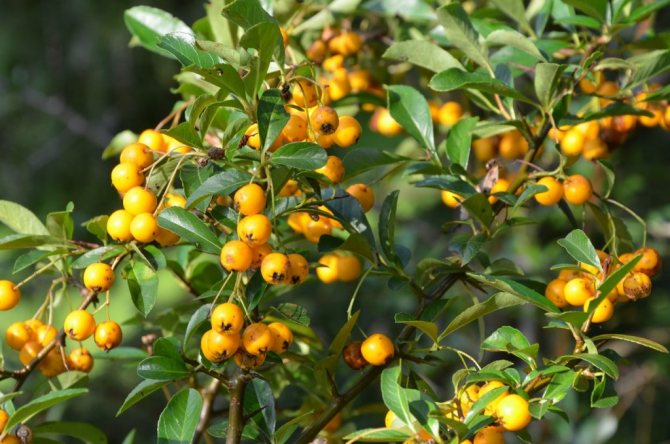

Today, the varietal variety of sea buckthorn is quite large.
Increasingly, sea buckthorn is planted in their personal plot and grown as a garden bole with tasty fruits that can be used both fresh and made for the winter. Moreover, each gardener chooses hybrids for himself with certain characteristics.
The most common are recognized:
- varieties with large berries
- without needles
- high-yielding varieties
- frost-resistant hybrids
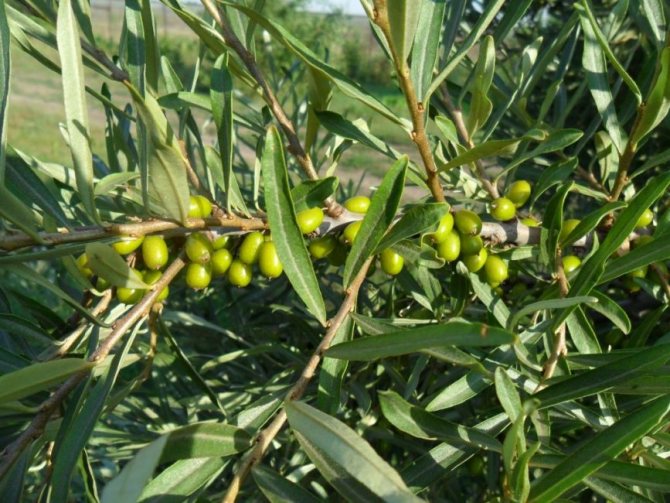

Sea buckthorn without needles
Everyone has the right to choose which of the varieties to grow on his site, for some the choice is so difficult that several plants with different indicators are planted at once. Such a gardener will always be with the harvest.
The bred plant varieties will have a lot in common:
- confusing the plant with other species will not work, the general description will be similar
- fruiting in hybrids will be more abundant
- berries are larger than wild trees
- the plant will have better resistance against diseases and pests
Frost resistance is not a distinctive feature of the newly introduced hybrids, sea buckthorn initially tolerates a strong drop in temperature and poor watering.
Next, we will consider the varieties of sea buckthorn in more detail, which will help with the choice of the garden for everyone.
back to menu ↑
See also: Blueberries: a description of the 25 best varieties from early to late ripening. Secrets of agricultural technology and useful properties of berries + Reviews
When and how best to plant sea buckthorn: in spring or autumn?
Sea buckthorn can be planted at any time - in spring, autumn, even summer. Gardeners argue about the best planting time, but there is no definite answer to this question.True, there are situations when spring planting has no alternative - it is safer and carries less risks for the seedlings.
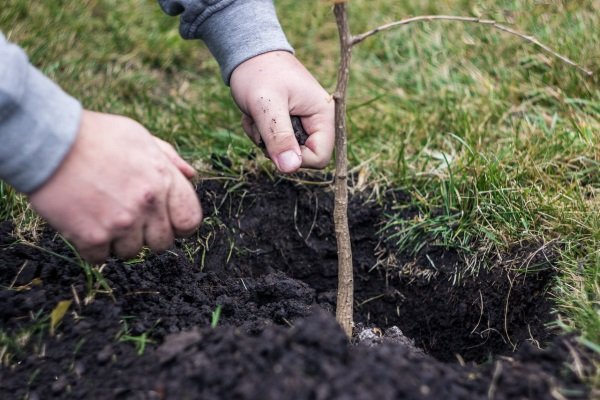

Planting sea buckthorn in autumn
An autumn planting is worth choosing if it is known for certain that the seedling grew in the same area. If the planting material is brought from warmer regions, the tree is able to "wake up" in winter - in January-February, and frosts are guaranteed to destroy it.
If the planting is carried out in the fall, then certainly until the second half of October, since later the seedling simply will not have time to take root before the onset of frost. Autumn planting is advisable under the condition of a long autumn, and the seedling is strong, healthy, and meets all the requirements for planting material.
For an autumn planting, a pit is prepared, and a soil mixture is poured into it. Ingredients of the soil mixture:
- fertile land;
- a handful of double superphosphate;
- humus bucket;
- glass of wood ash.
Further landing is carried out using standard technology. Preparing the soil mixture in the fall, and filling it into the pit, is one of the stages of spring planting. In the spring, seedlings can be planted in soil well-saturated with air and moisture.
If it is not possible to plant seedlings in the fall - for example, the timing does not allow, then they can be dug in to save until spring:
- dig a ditch 0.5 m deep;
- place the seedlings in the moat with the crowns facing south;
- dig in the seedlings with earth so that only the tops are visible;
- water the seedlings well;
- cover with spruce branches on top;
- when snow appears, fill up the shelter with it.
How to plant sea buckthorn in spring?
Most gardeners believe that it is better to plant sea buckthorn in the spring, before the buds open. In fact, the time of planting is selected taking into account the climate and the adaptability of the variety to its conditions.
Spring planting is definitely safer for a young plant. The seedling manages to take root reliably and get stronger before winter. Spring planting is done in late March or early April - while the plants are dormant.
The site for planting is being prepared in the fall. The soil is dug to the depth of the bayonet, making 1 sq. m:
- potassium sulfate - 20 g;
- superphosphate - 200 g;
- humus - 4-5 buckets.
In the spring, holes are dug with a depth and width of 65 cm. After 1.5-2 weeks, they start planting.
Outdoor planting and soil preparation
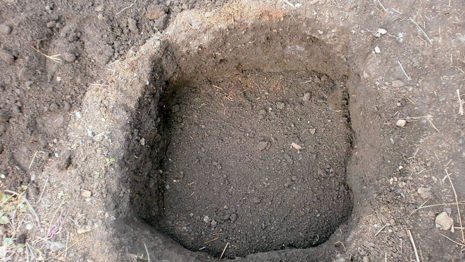

The planting site is prepared in advance: in the fall for spring plantings, for autumn plantings - a month before them. This allows the soil to be nourished with fertilizers and nutrients.
Landing rules:
- Dig holes 50x50x50cm in size, folding the soil from the lower and upper layers into different heaps.
- Lay out the drainage material (brick chips, small pebbles) in a layer at the bottom.
- Add humus (1 bucket), river sand (1 bucket), superphosphate (200g), wood ash (800g) to the removed top layer of earth and mix.
- Place the seedling in a hole, spread the roots and sprinkle with earth, leaving the root collar 5-7 cm above the ground. Dig in the garter peg at the same time.
- Form a hole around the stem, water abundantly, cover the soil with mulch (peat, sawdust) after absorbing moisture.
Where to plant sea buckthorn on the site?
Sea buckthorn has some features of the root system that should be taken into account when choosing a planting site. Its roots grow in breadth, moving away at a distance of up to 5 m from the tree. But they do not lie at all deep - when digging the soil, they can be easily damaged.
Sea buckthorn painfully tolerates root damage. That is why this plant should not be planted near garden beds - when digging up the soil, you can damage the roots. Preference is given to the edges of the site - sea buckthorn is planted around the perimeter, where no digging is planned.
general information
Sea buckthorn can grow as a shrub or small tree. The height of the plant can be either 15-20 cm or more than 6 m.The roots are located superficially at a depth of 35-40 cm, however, they grow in width to a distance of 70-100 cm.
The foliage of the sea buckthorn is long and narrow.The plates in the upper part are painted in green tones with specks, and in the lower part, silvery-white or reddish-golden shades prevail. Unisexual inflorescences are inconspicuous. They begin to open at the same time as the foliage opens. The plant blooms in late April.
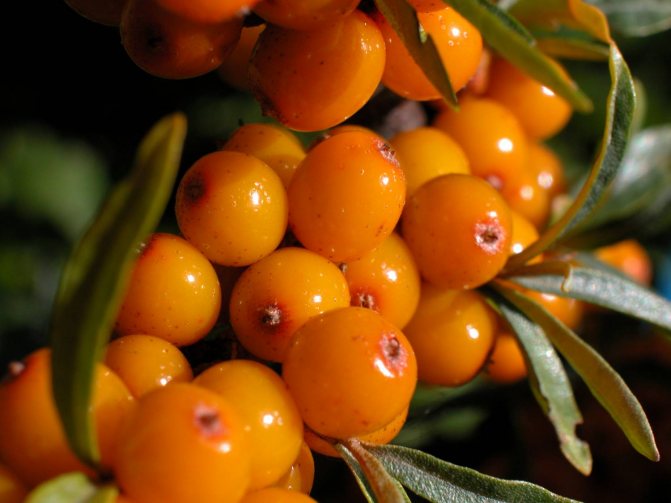

Sea buckthorn
The representative of the Lokhov family belongs to dioecious plants. The male silvery-brown flower forms a short inflorescence at the base of the young shoot, while the yellow female flowers appear one at a time in the bosom of the cover scales. The fruits of sea buckthorn are spherical drupes, which consist of a nut and an orange receptacle. The fruits ripen after 3 months.
Berries are used to make healing oils, jams and juice. To get a harvest, you must plant a male cultivar near the female plant, which will become a pollinator. One male bush can pollinate 4-6 female ones. The tree will begin to bear fruit 4-5 years after planting.
In the wild, sea buckthorn bushes can be found in Transbaikalia, Sayan, Tuva, Altai, in the southern regions of Kazakhstan and Central Asia. How to plant and cultivate a plant in open ground, where sea buckthorn grows, planting and caring for a shrub - all this will be discussed in this article.
Attention! The plant is winter-hardy and can withstand absolutely any frost.
What kind of soil does sea buckthorn like?
Sea buckthorn is not indifferent to moisture - it is not for nothing that it prefers to grow near water bodies. She needs soil that retains moisture well. The best option is black soil, loam and sandy loam soils. These soils retain moisture longer than others.
But moisture content should not be confused with boggy - sea buckthorn does not tolerate stagnant water. It is also unacceptable to plant this plant in places with a high occurrence of groundwater - less than 1 m to the soil surface.
In the video, an experienced gardener talks about what kind of soil sea buckthorn loves:
Sea buckthorn in nature prefers to grow on sandy and pebble soils, which is why there is so much of it in the coastal zone of rivers.
Seat selection
Sea buckthorn prefers sunny areas with dry soils (sandy, pebble) of neutral or alkaline acidity. In shaded areas, the berries grow smaller and less tasty. Closely located groundwater leads to root rot or poor root development.
If possible, it is best to plant sea buckthorn in a place protected from the wind on the south side of the building, near the fence, but not in the shade. It should also be taken into account that the roots of sea buckthorn grow by several meters, they are shallowly buried (30-40 cm), therefore, the proximity to any plants is undesirable for it.
You may be interested in: Edible honeysuckle: planting and caring for a plantHow to care for honeysuckle in autumn for a better harvestHoneysuckle care in autumn, preparation for winter
How to choose sea buckthorn for planting?
If sea buckthorn is planted in order to obtain fruit, varietal planting material is needed. In any case, the female plants must be purchased from the nursery. But with men it is easier - they can be wild. The optimum age for seedlings is 2 years.
Signs of a healthy seedling:
- there are 3 skeletal roots approximately 20 cm long, and a well-developed fibrous root system;
- seedling height - 30-50 cm, diameter - at least 6 mm;
- the trunk must have several shoots;
- bark - elastic, tightly attached to wood, color - light, not brown.
The brown color of the bark of a sea buckthorn seedling indicates its damage by low temperatures.
Seedlings are chosen from zoned varieties - this will protect them from early awakening, which is dangerous for their lives. For planting, choose grafted seedlings with well-developed roots and crown.
Ask in what way the planting material was obtained. If seeds or root shoots - varietal traits may not be transmitted. Seedlings grown from cuttings always convey the sex of the mother plant.
Landing requirements
Features of choosing a landing site for sea buckthorn:
- Sea buckthorn loves the sun, so it should be planted in areas open to the sun. Shading of the landing site is unacceptable. It happens that a seedling dies in the first years of life due to shading by weeds.
- Sea buckthorn is planted at a distance of several meters from fences and buildings. She also dislikes close proximity to trees.
- The best place for sea buckthorn is the south side of the site. They plant it on the very edge - so that the sea buckthorn does not interfere with catching the sun's rays.
Before planting sea buckthorn, the soil should be prepared. Check its acidity first. If the soil is acidic, add slaked lime to it. For 1 sq. m of soil - 300-400 g of lime. After scattering the lime, dig up the soil onto the bayonet of the shovel. Heavy clay soils make it easier by bringing in sand - two buckets per 1 sq. m.
2 weeks after adding lime, you can fertilize the site. First of all, organic matter is introduced - humus, manure, compost. Then mineral - superphosphate or complex fertilizers.
Fertilizers for planting seedlings can be applied both to the entire plot and to the planting pits. The distance between the landing holes is 2 m.
Preparing seedlings for planting
The procedure for preparing sea buckthorn seedlings for planting:
- If there are leaves on the seedlings, tear them off.
- Dip the roots of the seedling in water for 2-3 hours.
- Immediately before planting, dip the roots in a clay mash.
How to plant sea buckthorn in spring: step by step instructions
For spring planting, you should have prepared holes for planting - dug and fertilized. During the winter, the soil is infused, saturated with moisture and oxygen - the root system of the seedling will be comfortable in such an environment.
In the spring, it remains only to plant the seedlings prepared for planting. If several seedlings are to be planted, observe an interval of 2 m between them.
The order of planting a seedling in spring:
- Drive a stake in the center of the hole - this will be a support for the seedling. Bring the stake into hard ground so that it can withstand the winds.
- Rack the soil mixture into a hill to comfortably place the seedling roots on top of it. When placing a seedling in a pit, place it so that its root collar is 5-6 cm higher than the surface of the earth - it is strictly forbidden to bury it in the soil.
- Spread them out and start filling the hole with fertile soil mixed with humus, peat or coarse sand in a 1: 1 ratio. While backfilling, shake the seedling and tamp the soil with your hands so that there is no void between the roots. After covering the roots, carefully compact the soil around the seedling.
- Tie the seedling to a support. Use a soft material that won't damage the thin bark of the tree, such as twine.
- Water the seedlings - 2 buckets per seedling.
- Sprinkle mulch - dry grass, sawdust, or straw over the tree trunk.
The presented video shows step-by-step instructions for planting sea buckthorn, and also tells how to distinguish male from female sea buckthorn:
A male seedling is planted at the beginning of the row - from the windy side. Or in the center - surrounded by females.
When and how to transplant an adult sea buckthorn bush?
Transplanting sea buckthorn is a laborious and risky undertaking. Even observing the transplant technology to the subtleties, gardeners are often defeated - the bush dies. Transplanting is an undesirable event, so try to plant the seedling immediately in the right place.
A painless and successful transplant is possible for seedlings under 3 years of age. Features of sea buckthorn transplant:
- Dig up the plant carefully, along with all the roots and a clod of earth.
- Transfer the sea buckthorn to a new place - in a previously dug hole. Its dimensions should be such that a clod of earth, together with the roots, will comfortably fit in it. And most importantly - do not bury the root collar in the soil.
- Water the transplanted plant liberally and mulch the soil. In order for the sea buckthorn to take root better, add a root formation stimulator to the water for irrigation.
- Cut off part of the crown so that the plant does not waste energy on feeding the shoots, its task is to root faster.
- Spray the crown with Zircon or Epin (growth stimulants).
What can you plant next to sea buckthorn?
It is impossible to plant anything directly under the sea buckthorn except lawn grass. It is forbidden to plant plants near sea buckthorn with roots located shallowly - strawberries, raspberries, currants. Competing for nutrients, sea buckthorn will destroy them.
The best neighbor for sea buckthorn is sea buckthorn itself. Trees or shrubs are placed at a distance of 2-2.5 m from each other.
Thornless varieties
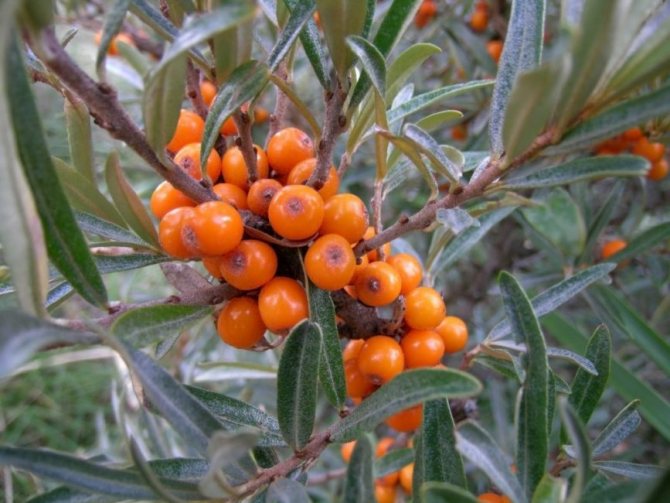

Sea buckthorn variety without thorns
Experts consider the cultivation of sea buckthorn varieties to be one of their best achievements in the field of breeding. Which do not have thorns. Thanks to this, crops can be harvested calmly, without fear of injury.
There are not so many such varieties, taking them out of the field of selection, experts tried to preserve other important properties of the trunk. As a result, we will now familiarize ourselves with the most successful results of the work done.
back to menu ↑
Read also: Hosta: description, types and varieties, planting in the open ground and care, possible diseases (120+ Photos & Videos) + Reviews
Giant
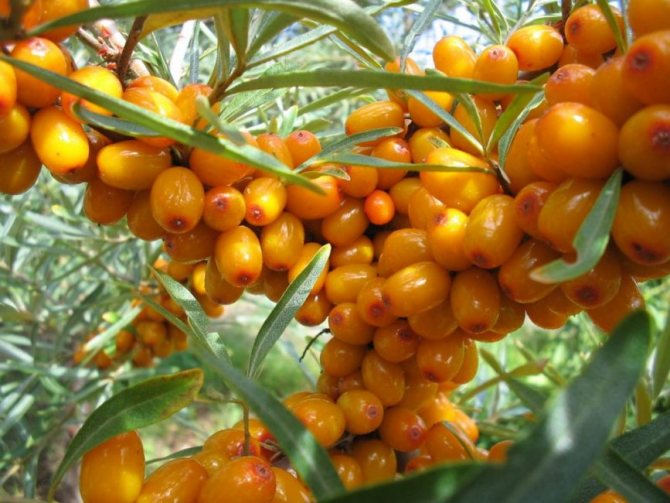

Giant The name of the stem was given because of two indicators, firstly, it grows up to 3.5 m in height, and secondly, it has rather large fruits.
A distinctive feature of the variety is that it can be a shrub, or it can grow as a tree with one trunk. Depending on how the pruning is carried out and the crown is formed, the plant will take on its appearance in the personal plot or in the garden.
Distinctive features are:
- the height of an adult plant can reach 3.5 m
- the crown has a conical shape even without trimming
- fruits are attached to the branches with short stalks that hold them tightly
- berries have a cylindrical shape, bright orange color and large size
Excellent sweet and sour taste allows the use of this variety of sea buckthorn for consumption in fresh and processed form for a long period.
Care for the trunk is required standard, the Giant will not need any frills. He perfectly cope with many fungal diseases, will perfectly endure the winter cold.
back to menu ↑
See also: Carrots: description, planting in open ground, care, feeding + Reviews
Sunny
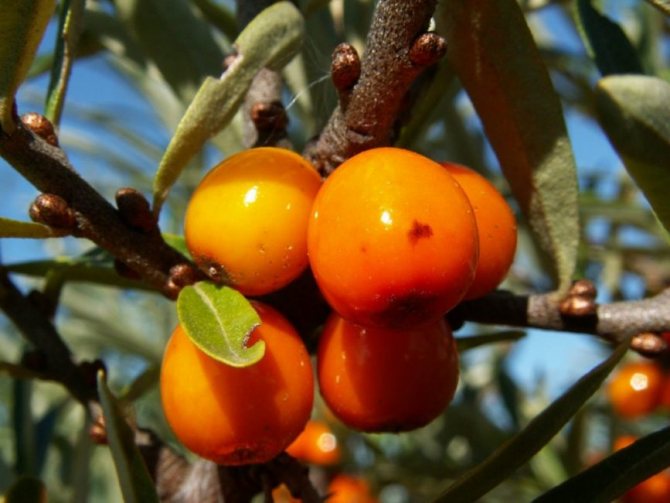

Sunny The sea buckthorn variety really looks like a piece of the sun in the garden from afar, it looks especially great during the ripening period, the branches are literally strewn with berries of a sunny color.
The main characteristics are the following indicators:
- bole is classified as a shrub because of its not high size and spreading crown
- there are no thorns on the trunk, which allows you to pick ripe berries without injury to the delicate skin of the hands
- ripe fruits have an amber hue
- to taste, sea buckthorn berries are sweet, have increased oiliness
- fruits are large enough, maximum can reach 0.7 grams each
- the stalk holds the berry firmly, even after full ripeness
In leaving, the stem is not whimsical, an important point will be regular pruning of the crown, clearing it of old branches, this will help to increase the size of the berries and the size of the yield.
Up to 6 kg of berries are harvested from the stem as much as possible; it begins to bear fruit from the 4th year of life. The negative aspects include late ripeness of fruits.
back to menu ↑
See also: Honeysuckle: a description of 19 popular varieties, their diversity and features, how to distinguish poisonous fruits (35 Photos & Videos) + Reviews
Altai
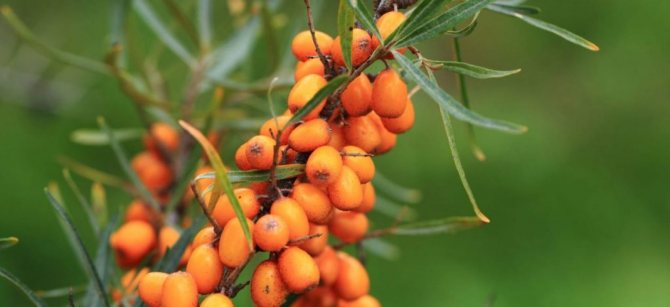

Altai The variety differs from the rest by the complete absence of thorns on the crown, which greatly simplifies harvesting. Ripe fruits are separated from the branches starting from the end of August, the stalk easily moves away from the berries, while leaving no wet trail. This factor significantly extends the fresh storage period of the crop, since the skin remains incomplete.
The ripe fruits of Altai sea buckthorn can reach a weight of 0.7 grams, have a pineapple smell and a slack taste. They are used both for fresh consumption and processed.
back to menu ↑
See also: We use manure as fertilizer: horse, rabbit, chicken, cow, pork, liquid and dry, as well as ready-made mixtures + Reviews
Friend
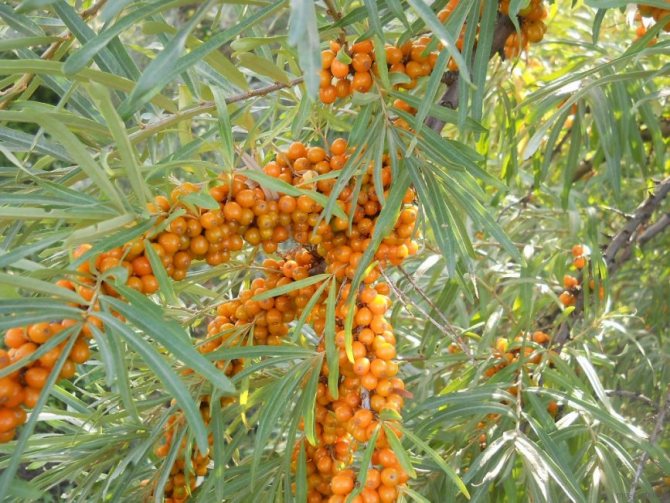

Friend The variety is most popular in the West Siberian region, here Podruga sea buckthorn is grown by almost all gardeners. The stem is classified as a universal variety that has an average ripening period.
The plant has the following characteristics:
- the crown of the trunk is medium spreading, grows weakly in height
- the branches of the plant are straight and thin, without thorns
- leaves characteristic of the trunk, light color with medium pubescence
- oval fruits, rich oval color, weighing up to a gram
Sweet and sour taste and thin skin allow fresh fruit to be used and processed.
The variety is high in vitamin C.
back to menu ↑
See also: Mulberry: description of 3 popular species, growing in the middle lane, reproduction and care, useful properties (50+ Photos & Videos) + Reviews
Sea buckthorn care after planting
Sea buckthorn is a useful and beautiful plant that will decorate any home garden. At the same time, it does not require much care from its owners - its agricultural technology is simple and does not differ in anything special.
The plant is resistant to pests and diseases, and the most important activity in the life of sea buckthorn is pruning - with its help, gardeners form a healthy and beautiful plant, removing unnecessary and damaged branches.
We recommend reading an article on how to properly care for sea buckthorn in the autumn.
Proper watering rules
Sea buckthorn is moisture-loving, it needs regular watering. During the growing season, especially in the first year after planting, the crop is watered regularly, taking into account the moisture content of the soil and weather conditions. The watering rate for one young plant is 3 buckets, during the fruiting period - 5-6 buckets. Mature trees are given more water - 7-8 buckets.
When watering, it is important to comply with the rate, waterlogged soil prevents air from reaching the roots.
When watering sea buckthorn, try to soak the entire trunk circle with moisture. With the approach of autumn, use 1.5 times more water. Do not forget to do one water-charging watering before winter - it is necessary for the plant's winter hardiness.
Loosening, weeding, mulching
After each rain or watering, the soil is loosened, and at the same time weeds are removed. The roots of the sea buckthorn are covered with nodules - bacteria live in them, which, assimilating nitrogen from the air, enrich the soil with nitrogenous compounds. The latter are vital to the plant. If the soil is covered with a crust, air will not flow to the roots, as a result, it will receive less nutrition.
When loosening, take into account the peculiarities of the sea buckthorn root system. In order not to damage the roots that are close to the surface of the earth, do not loosen the soil deeper than 6-7 cm. It is not at all recommended to dig up the soil in the near-trunk circle.
To reduce the amount of loosening and the risk of root injuries, sprinkle mulch on the near-stem circles. For this purpose, humus or compost is suitable - it can be prepared, for example, from potato tops or birch leaves.
How to do pruning correctly?
Sea buckthorn pruning can be carried out at any time, except for winter. But early spring is considered the best time for pruning. Pruning is carried out before the start of sap flow.
Spring pruning
In spring, the plant needs sanitary pruning - all dry, damaged and diseased branches are removed. On young sea buckthorn, formative pruning is also carried out, the gardener decides how the plant will grow - in the form of a tree or a bush.
Principles and features of pruning sea buckthorn in the spring:
- A young seedling is immediately cut to a height of 10-20 cm. The stump will sprout branches, and shoots will also grow from the root.The next year, the gardener chooses the 4 most powerful shoots, the remaining are cut off. Root shoots can only be left with self-rooted seedlings.
- When forming a tree, a stem with a height of 30 cm is created at the seedling, and 2-4 skeletal branches are left. If the branches of the seedling are fully formed, you do not need to prune it. If there are no branches on them, shortening to 30 cm is necessary.
- In the second year, 3-4 skeletal branches and a guide are formed from the grown shoots - then they are cut off at the same level.
- If after a year the shoots grow too intensively, they are shortened by a third or a quarter.
- When the plant begins to bear fruit, the pruning of the upper parts of the shoots is stopped - flower buds form on them.
After the tree is formed, it remains only to regularly cut off excess shoots:
- growing inside a tree / shrub;
- thickening plant;
- shoots - they cut it off, digging out the shoots and carefully cutting it into a ring.
When sea buckthorn is 6 years old, it will need anti-aging pruning. It is also best done in the spring. Branches that have ceased to bear fruit are removed, replacing them with young and strong shoots. Every year 1-3 branches are replaced - it is no longer possible.
Watch a video on the correct pruning of sea buckthorn:
Plants affected by frost are cut down to the root collar. If the roots are still alive, then a new bush or tree can be formed.
Pruning in the fall
In late autumn, when the dormant period begins for sea buckthorn, sanitary pruning is carried out. All old branches, thickening, incorrectly grown, diseased, dry, etc. are removed. Pruning is carried out with a sharply sharpened, disinfected instrument.
How to fertilize sea buckthorn?
Top dressing begins in the second year after planting. Organic matter is introduced annually - 1 bucket of humus or compost for each square meter. In adult plants, the root system itself provides the plant with nitrogen, so they only need phosphorus and potassium fertilizers - they are applied to the soil. But until the age of 5 years old, sea buckthorn is fed with nitrogen, scattering ammonium nitrate around the trunk circle - 20 g per 1 sq. m.
After flowering, fruit-bearing sea buckthorn is given foliar feeding - it is sprayed with a solution of potassium humate (for 10 liters of water - 1 tbsp. L). After 20 days - re-feeding.
When forming ovaries, it is recommended to feed the plant with a nutrient mixture. Composition and dosage per 10 l of water:
- wood ash - 100 g;
- superphosphate - 30 g;
- potassium salt - 25 g.
This amount is enough for 1 sq. m of soil. Acidic soils are fertilized with a mixture in which superphosphate is replaced with phosphorite flour - 50 g per 1 sq. m.
It is recommended to feed the sea buckthorn 4 times during the season:
- early spring;
- during the flowering period (watered with a solution of potassium humate);
- after flowering;
- 20 days after the last feeding.
Preparing culture for winter
Sea buckthorn is a frost-resistant crop, so gardeners usually do not insulate it. But there are measures that can help the plant to withstand severe frosts more easily.
Winter preparations:
- warming of the root zone with spruce branches and sod;
- whitewashing the trunk;
- barrel protection with a metal mesh - to protect against rodents.
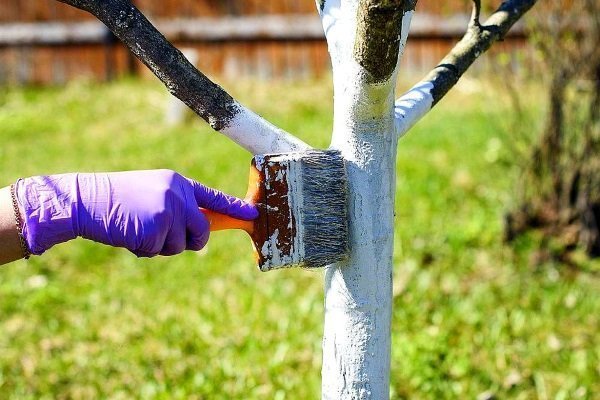

Care depending on the region
Sea buckthorn can grow in any regions of the Russian Federation - in the south, in the middle lane, in the north, in Siberia. Depending on the climatic conditions, the landing dates and the nuances of care change.
Planting and caring for sea buckthorn in the Moscow region
In the Moscow region, sea buckthorn is planted in late March or early April, depending on the weather. Disembarkation is carried out before the start of sap flow, but a positive temperature should be established. To reduce the hassle and risks, only zoned varieties should be planted.
The climate of the Moscow region is perfect for sea buckthorn. About 60 varieties are zoned here - there is plenty to choose from. It is not necessary to insulate such sea buckthorn. The varieties recommended for the Moscow region are shown in table 2.
table 2
| Variety | Botanical form (bush / tree) | Number of spikes | Fruit | Yield per plant, kg |
| Moscow pineapple | compact bush | insignificant | dark orange, with a red speck at the top | up to 14 |
| Lomonosovskaya | medium-sized tree | insignificant | large, orange-red | 14-16 |
| Botanical amateur | medium-sized tree | insignificant | large, yellow-orange | up to 20 |
| Botanical aromatic | medium-sized, spreading tree | insignificant | orange-brown | 12-14 |
| Fragrant | medium-sized tree | average | large, red-orange | up to 16 |
Planting and caring for sea buckthorn in the Siberian region
In Siberia, sea buckthorn is planted in late April or early May - they expect stable heat. For Siberia, many varieties of sea buckthorn have been bred, which can withstand the harsh climate without problems. In Siberia, the agricultural technology of growing the crop in question is no different from the work carried out in the middle lane. Popular sea buckthorn varieties for Siberia are listed in Table 3.
Table 3
| Variety | Botanical form (bush / tree) | Number of spikes | Fruit | Yield per plant, kg |
| Golden Siberia | medium-sized bush | very little | orange | 12-14 |
| Zhivko | medium-sized multi-stem bush | few | orange-yellow | to 10 |
| Elizabeth | medium-sized bush | very little | orange | up to 12 |
| Jam | weak bush | not | orange-red | 12-15 |
| Giant | medium-sized bush | not | orange | 13-20 |
| Altai | medium-sized compact bush | not | bright orange | 12-14 |
Large-fruited varieties
Under natural conditions, with normal development, sea buckthorn has rather small fruits, each of which weighs no more than 0.4 g. It will take a long time and a sufficient number of trees to collect the required number of fruits.
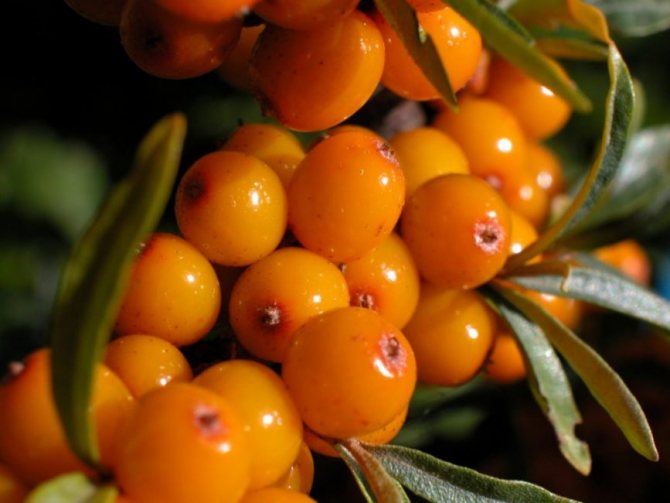

Large-fruited sea buckthorn
To save time, breeders specially bred several varieties of sea buckthorn with large fruits, each of which can reach up to 1.5 grams. At the same time, most of the gustatory characteristics have been completely preserved, the appearance and other properties of the stem are also largely preserved.
Most large-fruited varieties are distinguished by abundant fruiting, but this does not last long. After 5-7 years, the fruits become smaller and the yields become less abundant.
Next, we will get acquainted with the most popular varieties among gardeners, which have proven themselves on the positive side.
back to menu ↑
See also: Homemade rose in a pot: how to care for it after buying it at home? (20+ Photos & Videos) + Reviews
Openwork
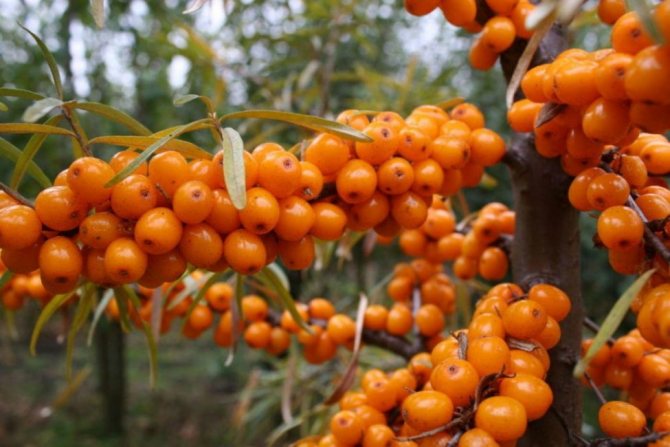

Sea Buckthorn Openwork This variety has come to the taste of many experienced gardeners and beginners in this business. It is easy to grow, the stem is not picky about soil and weather conditions, it bears excellent fruit in any region.
An adult fruiting tree of the Azhurnaya variety has a wide spreading crown, in addition, the stem stands out:
- the complete absence of thorns on the branches
- large cylindrical fruits of orange color
- early ripening of berries
- abundant fruiting
During the first tests in the harsh north, Openwork sea buckthorn showed high resistance to frosting of buds and branches. She is not afraid of most fungal diseases that affect the fruit trees of the garden, the stem perfectly tolerates the dry months of summer and will not die with an abundance of moisture in the spring-autumn period.
The harvested crop perfectly tolerates long-distance transportation. The berries are eaten fresh and preserved in various ways. Openwork sea buckthorn is subject to conservation, freezing and other types of processing for a longer preservation.
back to menu ↑
See also: Black currant: 30 best varieties of the sweetest summer berry. Description of early, mid-ripening, late, large-fruited and frost-resistant varieties (35+ Photo & Video) + Reviews
Augustine
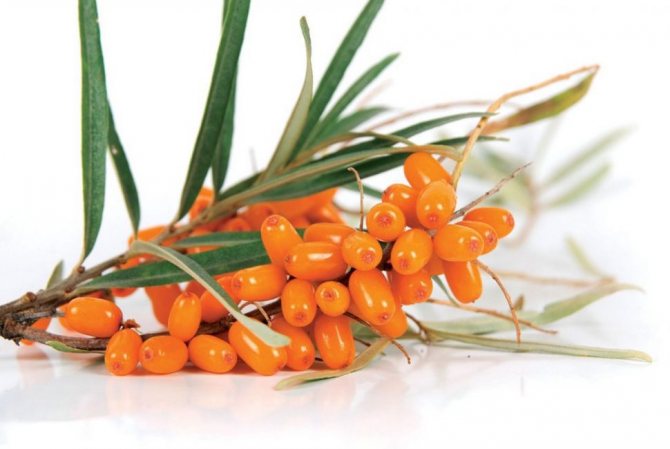

Augustine's sea buckthorn This variety is slightly similar to the previous one, the adult bole is distinguished by a spreading crown with characteristic green leaves.In terms of ripening Augustine is considered early ripening, the ripening of fruits begins at the end of July under appropriate weather conditions, in the northern regions the fruits of sea buckthorn will ripen no later than August, from here and the name of the variety.
Distinctive characteristics are:
- fruits are orange and ovoid
- berries are large enough, each weighs a little over a gram
- the fruits are collected on the branches in bunches, which, when ripe, yield the harvest without problems
The presence of a small number of thorns is allowed on the trunk. An important point is the yield, an average of 16-18 kg of useful berries are harvested from an adult tree.
The sea buckthorn variety grows in regions with different weather conditions, it tolerates both the cold and the lack of moisture in the required quantities. Not afraid of fungal diseases, resistant to various pests.
back to menu ↑
See also: Ever-flowering begonia: description, types, planting in the open field and care, possible diseases (60 Photos & Video) + Reviews
Elizabeth
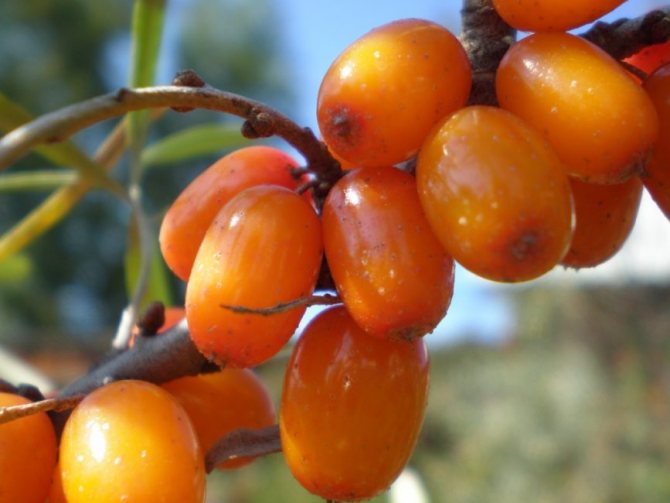

Elizaveta variety Pests are not terrible for the sea buckthorn variety Elizabeth, but it will have a later ripening period. An adult bole looks more like a shrub with a compact crown than a tree. The plant will not take up much space in the garden, but it will be generous in fruit. With proper care, it will be possible to harvest up to 14 kg of berries from it annually.
In the care for Elizabeth, the main thing is pruning, but it is also carried out once a year, in early spring. The rest of the stem is absolutely identical to any sea buckthorn.
Distinctive features of Elizabeth are recognized:
- large fruit size, each can reach up to a gram
- the variety is appreciated for its taste, ripe berries have a pleasant sweet and sour taste and a light pineapple aftertaste
- the trunk is not afraid of severe frosts
- pests and diseases will not overcome the shrub with proper care
Later ripening periods endowed the fruits with a strong skin, which reliably keeps the pulp from damage and spoilage. Thanks to this, the berries are kept fresh for a long time, they are canned and frozen to increase the shelf life.
back to menu ↑
See also: Dogwood: description, planting in the open field, care, reproduction, possible diseases - a plant for all occasions (50+ Photos & Videos) + Reviews
Essel
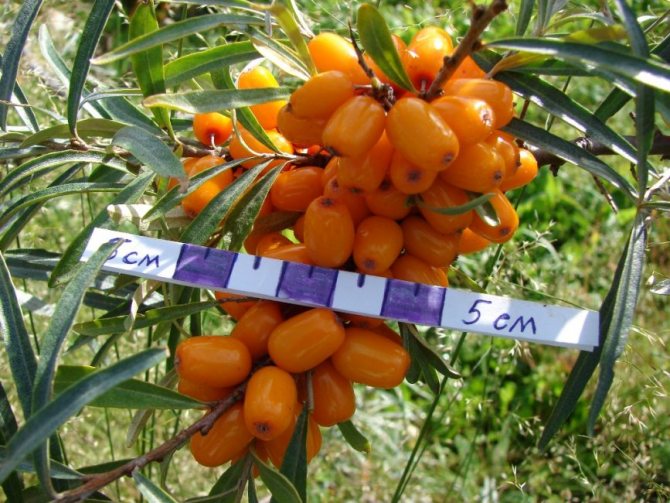

Essel The variety belongs to the novelties of Siberian selection, it is several years old. But even in such a short period, the stem managed to win the sympathy of many gardeners in this region.
Among the advantages of the variety are:
- excellent taste characteristics, dessert taste cannot be confused with any other variety
- large fruits are also characteristic of Esseli, each of them can reach up to one and a half grams of weight
- the trunk is characterized by oval-shaped fruits with a rich orange color
Fruit ripening begins in mid-August, in the southern regions the berries are poured earlier. It is worth paying special attention to the berries during this period, overriding they will fall from the branches, since they have underdeveloped stalks, which collect them in a brush on the branches.
The stem does not need special care, the main thing is to trim the branches and form the crown. In the future, it is enough to remove dry and old branches, then fruiting will be abundant, the size of the berries will remain the original.
This bole is especially in demand among the residents of Altai.
Reproduction of sea buckthorn
Sea buckthorn reproduces well by different methods - seeds, cuttings, layering, shoots, grafting, dividing the bush. Each gardener decides for himself how it is more convenient for him to propagate the plant.
Vaccination
This is the most difficult and time consuming breeding method. It is used only by experienced gardeners. Vaccination goals:
- A male stalk is grafted onto a female bush so as not to plant a new seedling.
- For the cultivation of varietal plants on viable rootstocks.
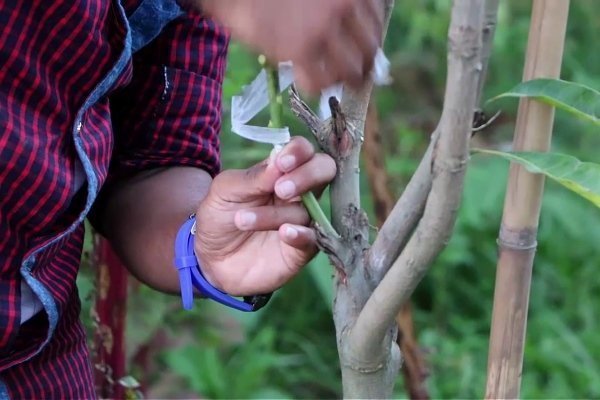

Features and procedure for grafting sea buckthorn:
- Start vaccinations in late April or early May.
- For the rootstock, use a two-year-old seedling grown from seed.
- Cut the rootstock trunk 15 cm above the root collar. Leave one powerful shoot 10 cm high on the rootstock, cut off all others.
- Over the summer, the abandoned shoot should get stronger. Pinch it to make it thicker and not grow up. Remove all growths at the bottom - at a height of up to 15 cm.
- By the next spring, the shoot turns into a bole.
- By the third spring, the height of the plant reaches 50-60 cm, and its diameter is 5-9 mm. Copulate at a height of 10 cm from the root collar.
Gardeners have noticed that cuttings taken from male plants and grafted onto the stock take root worse than cuttings taken from female plants.
Seed reproduction
If you are interested in obtaining a varietal plant, the seed propagation method is not suitable for you. The plant obtained from the seed does not bear the varietal characteristics of the mother bush (tree). Seedlings are usually used as rootstocks for grafting.
Features of seed propagation:
- Seed germination lasts at least 2 years.
- Before sowing, the seeds are kept in the refrigerator for 1.5 months - on a vegetable shelf.
- North - at the end of April. The seeds are not very deep. The container with seeds is covered with foil or glass and placed in a warm, bright place. Shoots will appear in 1-2 weeks.
- In mid-July, the seedlings are transplanted to a permanent place. Before planting, their taproot is shortened.
Cuttings
Cuttings are harvested in autumn - late November-early December, or in spring - late March-early April. Use 2-year increments with a thickness of at least 6 mm. The length of the cuttings is 15-20 cm. The autumn cuttings, tied in a bunch, are wrapped in cloth and polyethylene, and stored, covered with soil, spruce branches and snow.
The order of planting cuttings in spring:
- Cuttings are placed in water for 3 days - it is regularly changed. Many gardeners add a root growth stimulant to their water.
- Cuttings are planted in the ground - with a slight slope. At least 2-3 buds should remain above the ground. Most of the kidneys end up in the ground. By autumn, the stalk grows up to 60 cm. In the 3rd year, the plant will give its first fruits.
Green cuttings are more difficult to root than woody cuttings. You have to create special conditions, you need a loose soil mixture, sand, growth stimulants, water spraying, etc.
Layers
For this method, you will need a young sea buckthorn with well-bending branches. The order of reproduction by layering:
- Select branches with good growth in spring.
- Bend the selected branch and place it in a shallow groove.
- Commit the branch. Cover the groove with earth.
- Water, feed, and loosen the soil throughout the season.
By next spring, the cuttings will strengthen. Dig it up by cutting it off from the mother plant and replant it to a permanent location.
Undergrowth
Features of reproduction by shoots:
- For reproduction, choose shoots that are 1.5 m away from the mother plant and further - their root system, as a rule, is already formed.
- Spud the shoots high, feed and water them during the season.
- In the spring, cut off the offshoots chosen for breeding and plant them in a permanent place.
By dividing the bush
The order of reproduction of sea buckthorn by dividing the bush:
- Dig up a bush and cut off old branches.
- Divide the bush with pruning shears. Each delenka must have a developed root system.
- Sprinkle charcoal over the cut area.
- Plant parts of the bush in planting holes. Next, care for ordinary seedlings.
Reproduction and selection of a seedling
How sea buckthorn reproduces
Reproduction of sea buckthorn is possible by seed and vegetative method. The seeds can be purchased at any specialty store.
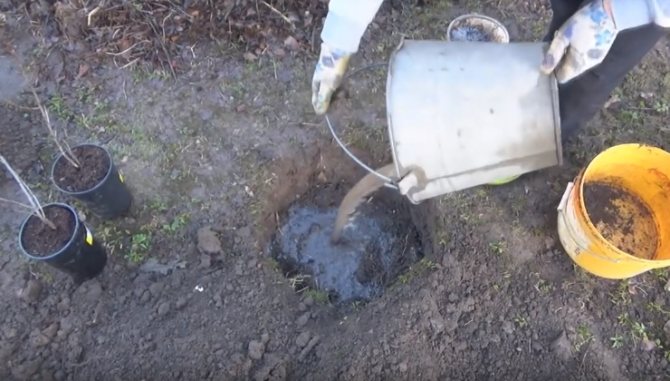

Planting sea buckthorn
It is rather difficult to distinguish an off-grade seedling from a cultivated shoot, which was propagated by cuttings. If the roots look much thinner than the top of the young tree, you can be sure that this is an outgrowth of the root system. It is best to purchase a small seedling that has been grown from a cuttings.
Shrub propagation by green cuttings
Cutting sea buckthorn is similar to cutting other shrubs. This system is recognized as the most effective of the breeding methods. At the beginning of summer, you should cut off a 15 cm stalk and remove several of the bottom sheets from it. The slice is treated with growth substances. The stalk is placed in the nutrient soil of the greenhouse and covered with foil. The combination of peat and river sand with fertile soil will make it possible to fertilize the cutting well and create favorable conditions for active growth. The humidity in the greenhouse must be kept at 90%.


Sea buckthorn
Further actions are reduced to:
- Systematic watering and spraying of the cuttings.
- Conducting fertilizing with mineral fertilizers after the appearance of the roots.
- Hardening by airing.
- Removing the film from the cutting and fertilizing with phosphorus-potassium complementary foods after it is fully strengthened.
- In April, you can transplant a seedling to a permanent place.
Propagation using woody cuttings
At the end of November, cuttings, the thickness of which exceeds 5 mm, are cut and buried in a snowdrift so that the plant continues to sleep. With the onset of spring, workpieces can be cut off, the length of which will be 15 cm and placed in water for several days. Only after this is the seedling lowered into a solution that increases the growth rate of the plant.
Important! When the growth of the cutting exceeds 50 cm, and the length of its root collar is 10-12 cm, it will be ready for transplanting into open ground.
As soon as the first roots appear, the seedling should be planted in fertile soil to a depth of 12-16 cm. It is best to mix the soil with peat, humus and river sand. After that, you can cover the tree with foil material. 2-4 buds should remain above the ground. A young seedling needs systematic watering.
Growing sea buckthorn in the country is a rather laborious process, in which it is important to collect preliminary information from specialists and strictly follow it. Any disease can affect the plant. From year to year, trees need to be treated with fungicides. It is equally important to make timely fertilizers, top dressing in order to nourish the tree with useful substances and accelerate its growth.
Systematic watering will allow you to get a bountiful harvest. The berries will be juicy and large. However, it is also not worth pouring the plants daily, the sea buckthorn will become watery, and the roots will begin to rot. Adhering to the basic rules and recommendations of specialists regarding the care of sea buckthorn, you can grow a healthy tree that will delight you with a good harvest.
Flowering and fruiting
Male (staminate) flowers bloom on male plants. On female - female (pistillate) flowers. Stamen flowers are sources of pollen necessary for fruiting. The pollen enters the female plant through the air - there will be fruits. Male bushes do not bear fruit.
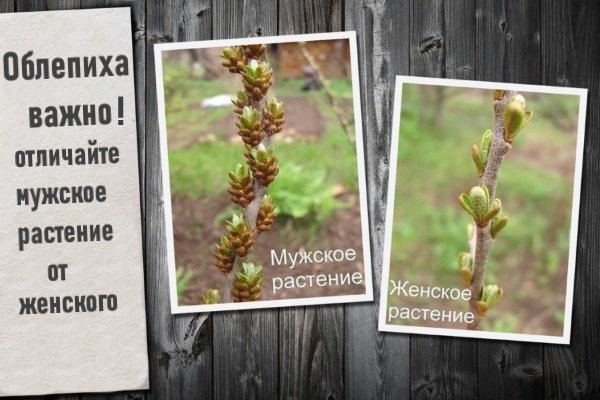

Blooming sea buckthorn
The flowering of heterosexual plants must occur simultaneously, otherwise there is no point in their neighborhood. The timing of flowering is influenced by weather conditions and climate. In the middle lane, the culture blooms in the 2nd half of May, blooms for half a month. In Siberia, sea buckthorn blooms at the end of May.
There are no nectaries in sea buckthorn flowers. Plants have to rely mainly on the wind. If the weather is calm, gardeners have to work as pollinators. To transfer the pollen to the female flowers, they cut off the branches and fan the female plant with them.
In what year does sea buckthorn bear fruit after planting?
The first fruits on sea buckthorn are expected by the fourth year. But a full-fledged crop is harvested only in the 6th year of life. At this age, the plant (tree or shrub) finishes forming, and directs all vitality to the harvest.
General information
To get a good harvest of sea buckthorn, you should carefully study the weather conditions of your region, soils, their moisture content and composition will become an important indicator. Based on these indicators, they start choosing a variety.You should not choose only plentifully fruiting varieties, with proper care and a properly selected variety in your garden, sea buckthorn will always bear fruit well.
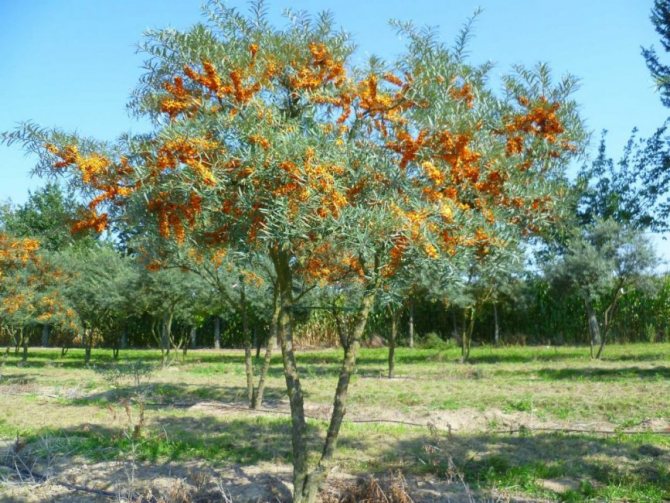

Growing sea buckthorn is not a troublesome business
Preventive measures will also become important points, even if it is written in the characteristics of the stem that it has immunity to diseases and pests. Simple spraying at the beginning of the season will completely protect the plant from unpleasant environmental influences on the green part of the crown and keep the fruits in full.
Regular fertilization in the spring, light mulching of the soil around the shrub will increase yields, give the plant more vitality for growth and development.
Growing sea buckthorn in a personal plot or in a garden is not troublesome, but in order to get good yields, some attention will have to be paid to the shrub.
back to menu ↑
See also: Homemade medlar: how to grow the favorite fruit of the Japanese from a bone on a windowsill (45 Photos & Video) + Reviews
Sea buckthorn growing business
The most valuable sea buckthorn product is sea buckthorn oil. It is made from yellow (orange) fruits that grow in abundance on female plants. Sea buckthorn oil is used for medical purposes, in cosmetology, it is a very valuable product with regenerating properties.
On an industrial scale, sea buckthorn is grown mainly for oil production. For this purpose, special technical varieties are planted - their fruits do not taste good, but they contain a lot of oil - 6.2-6.8%. Dessert varieties contain 2-6% oil.
Today, medicinal crops are in high demand on the market. Exotic products are being replaced by proven products grown at home. Sea buckthorn is unpretentious, hardy, does not require a lot of labor - it can become the subject of an excellent business. The cost of planting 1 hectare of sea buckthorn is about 2,000 euros. The investment pays off in 3 years. At least 15 tons are harvested from 1 hectare. The price of 1 kg is 150 rubles.
Sea buckthorn oil is not the only product derived from sea buckthorn fruits. The market can also be offered:
- fresh sea buckthorn;
- dried fruits;
- frozen fruits;
- syrups;
- tinctures;
- jam;
- the juice.
Sea buckthorn leaves are also useful - they are dried and tea is brewed. Leaves can be dried, packaged and sold. Another interesting idea is to place an apiary next to the sea buckthorn plantation - you can get valuable sea buckthorn honey.
Harvesting and processing
The term for picking sea buckthorn berries depends on the characteristics of the variety. So the fruits of early maturing crops can be picked at the end of August. For late-ripening varieties, the harvesting period is delayed to mid-September. Ripe berries have an intense color, easily detach from the stalks.
Some gardeners harvest sea buckthorn after the first frost in cloudy weather. Under such conditions, the fruits are much easier to separate from the branches.
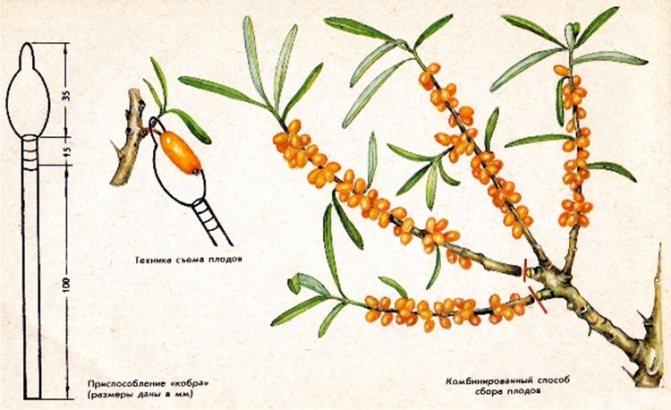

Harvesting sea buckthorn must take into account the following rules:
- Put on rubber gloves and an apron before starting work. Protective clothing will prevent sap from getting on the skin and will also protect the collector from sharp thorns.
- The fruits are plucked from the top to the bottom of the branches.
- Some gardeners use tongs to harvest the fruit, but the harvesting process is very slow.
- Devices such as a scraper, a steel wire cobra, and a slingshot with a stretched line help speed up the process.
If the berries are going to be processed for juice, and you don't want to collect them, you can put on rubber gloves and place the container under the branch. As a result of successive movements from top to bottom, together with squeezing the berries, up to 4 liters of juice per hour are obtained. Ripe berries that have been frozen can be easily shaken off the tree onto a sent film or cloth.
Many people know about the benefits of sea buckthorn, its fruits and leaves contain a huge amount of vitamins, amino acids and other active substances.The collected berries are washed and dried, placed in plastic bags and stored in the freezer. In addition, the fruits can be sprinkled with sugar and placed in the refrigerator in plastic containers. Also, jam is made from fresh sea buckthorn, juice is squeezed out and oil is extracted.
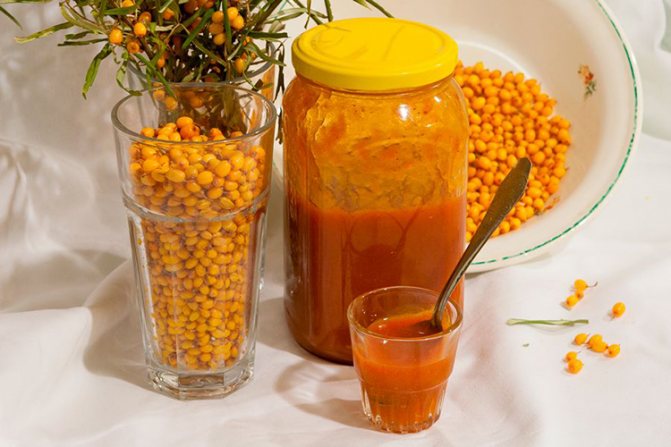

Diseases and pests
Compared to other fruit crops, sea buckthorn rarely gets sick. But there are several diseases that can be very dangerous for sea buckthorn. Table 4 - common diseases and pests of sea buckthorn, and measures to control them.
Table 4
| Diseases / pests | Symptoms / Harm | How to fight? |
| Verticillosis | A fungal disease that causes the rapid wilting of leaves and fruits, and then the whole tree. | There is no cure. A sick tree is uprooted. At the place of growth, they are quarantined for 2-3 years. |
| Endomycosis | Fungal disease that affects the fruits of the plant shortly before technical ripeness. | Sprayed with copper oxychloride during the growing season. Be sure to re-sprinkle after the fruit ovary. |
| Blackleg | Fungal disease thinning the trunks of seedlings. | Seedlings are watered with a solution of potassium permanganate - once a week, and if necessary, if the disease begins to manifest itself, daily. |
| Sea buckthorn moth | Caterpillars eat buds and leaves. | Spraying with 0.5% Chlorophos during bud break. |
| Sea buckthorn fly | Fruits are affected - they shrivel and wither. | Treatment in July with a solution of Chlorophos 0.2%. |
| Sea buckthorn aphid | Sucks juices from leaves. Weakens the plant - death is possible. | Twice sprayed with Karbofos 10% - during bud break and again after 2 weeks. |
Sea buckthorn transplant
It is better to spend it in the spring to avoid the risk of freezing. A plant at the age of 2-3 years transplant easily, and an adult plant may die. But, if necessary, an autumn transplant is also possible.
How to transplant:
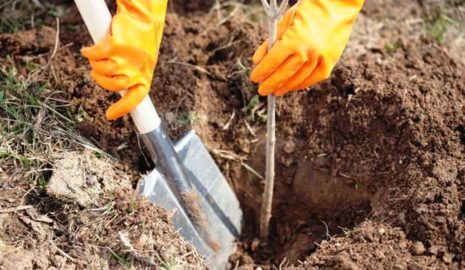

- rake off the earth from the trunk and bare the roots, determining which one is maternal;
- cut off the main root, leaving 20-30cm;
- plant like a seedling.
Harvesting sea buckthorn
Harvesting sea buckthorn is a laborious task, and it is especially difficult to harvest fruits from thorny varieties. Therefore, gardeners have invented a huge number of devices to facilitate harvesting.
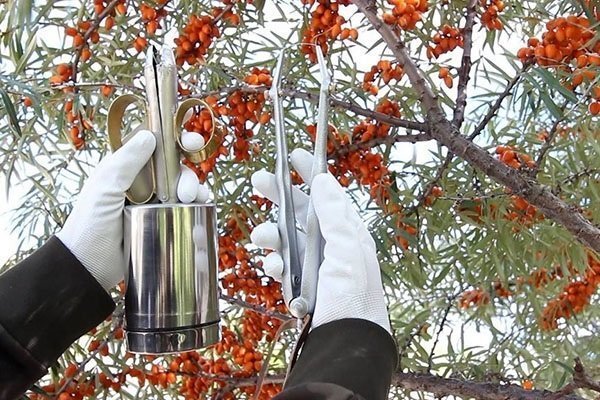

Hand picking berries
Hand picking from a tree is a grueling task, only permissible with small volumes of harvest. An easy way to collect:
- cut off the branches with berries;
- put the branches in the freezer;
- after a day, remove the branches to remove the berries, just run your hand over them.
Carefully cut the branches with a secateurs - breaking them off is unacceptable. Only fruiting shoots that are subject to sanitization in the fall are subject to cutting. You can wait for frost and shake the branches. Fruits and leaves fall - all that remains is to sort them out.
In October, sea buckthorn is harvested for oil and juice, wearing rubber gloves. The berries are pressed directly on the branch, dropping the cake and juice into the substituted container. Before harvesting, the plant is watered with water from a hose - to wash off the dust from the fruits.
Mechanical berry picking
To harvest from several trees or from an entire sea buckthorn plantation, you cannot do without mechanical devices. Quite a lot of them have been invented and produced:
- Forceps. Sold in stores. Collecting is faster, but still time consuming. Plus - the tree is not injured. It is fashionable to remove each berry separately with tongs. This option is suitable for 1-2 trees, no more.
- Slingshot. The berries are cut from the branches. The tool is made of wire stretched over a suitable attachment, such as a vegetable peeler. The cut berries fall directly into the collection container. Minus - the risk of cutting off fruit buds.
- Scraper. Quickly cleans branches from berries. Looks like a slingshot with tongs. Clutching a branch, they pull the tool towards themselves, and the cut fruits fall into the container.
- Harvester. It is an industrial tool made of plastic. Allows you to pick berries without damaging the plant.Combines of different configurations are produced, but they all operate according to the same principle. The harvester is a manual attachment with a container for berries. The fruit is cut with a comb-like working surface.
Sea buckthorn is one of the most unpretentious and hardy fruit crops. It does not require special care, it multiplies easily and practically does not get sick, and the most difficult moment in its cultivation is harvesting. Sea buckthorn is an ideal garden dweller that can generate real commercial profits.
0
High-yield varieties
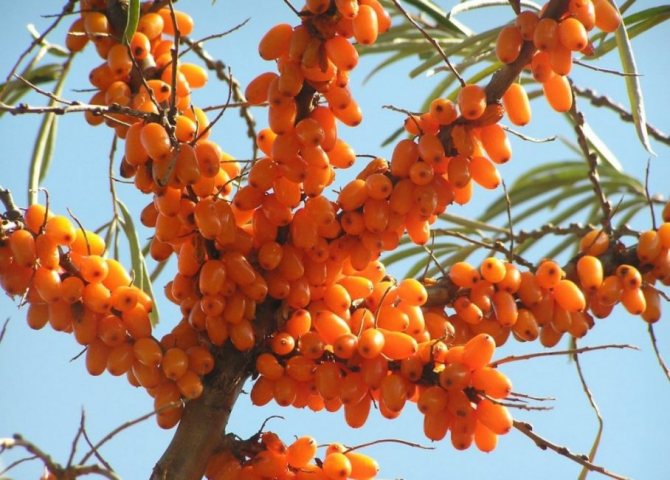

Good harvest of sea buckthorn
Wild-growing sea buckthorn stems do not give very large yields, even from an adult tree, no more than 6 kg of healthy and tasty berries can be harvested. At home, in order to provide the required amount of fruits, you will need to plant many such trees, but what if there is not enough space? How to place a large number of plants?
It is to solve this problem that breeders have bred varieties, the yield of which is three times higher than the average. One such bole will replace 3-4 wild-growing plants, while the selection was carried out in such a way that all the beneficial properties of sea buckthorn were preserved and increased for some varieties.
In care, the varieties are not picky, most will be able to grow and develop even on scarce soils under not very favorable conditions. But these indicators will directly affect the yield, under such conditions it will be lower than the stated figures.
back to menu ↑
Read also: Strawberry - description of the 33 best varieties: early, mid-season, late and remontant varieties | + Reviews
Botanical
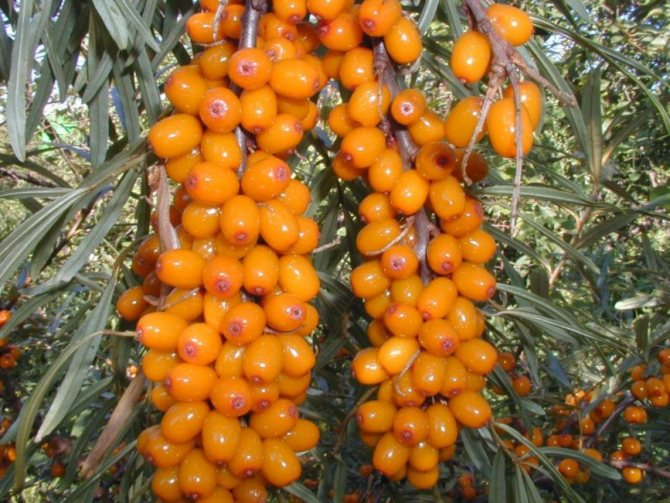

Botanical The variety is not at all large in size, the crown is compact, spreading. With proper care, up to 20 kg of berries are harvested from the trunk at the 5th year of life. The stem has the following characteristics:
- the leaves of the variety are medium, with a green color on top and bluish on the bottom
- there are practically no thorns on the plant
- berries are large, when mature they have a bright orange color
- there are many fruits, when ripe, the branches turn almost completely orange
- fruits easily detach from the stalks when harvesting
- harvested berries perfectly tolerate transportation, can be kept fresh for a long time if the necessary conditions are created
The Batanicheskaya variety is often used by the horticultural farms of Siberia; there are entire plantations from this particular sea buckthorn variety. The variety is also preferred because of its resistance to fungal drying and various pests.
back to menu ↑
See also: Bubbles: species, description of 18 popular varieties, planting and care (80+ Photos & Videos) + Reviews
Abundant
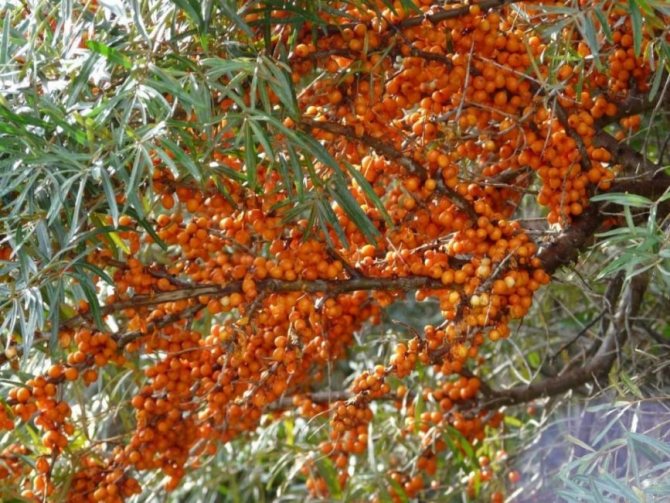

Abundant This variety is distinguished by its stature, the crown is large, spreading, dense. The plant is characterized by early ripening of fruits, abundant yield, on average up to 14 kg from one stem, thorns on adult plants are almost completely absent.
The berries are large, rich orange in color, each fruit weighs at least 0.7 grams. They are attached to the branches with elongated stalks, which easily give off berries in the ripening field.
back to menu ↑
See also: Strawberries: in the open field and in the greenhouse - we choose a suitable growing method for ourselves
Moscow beauty
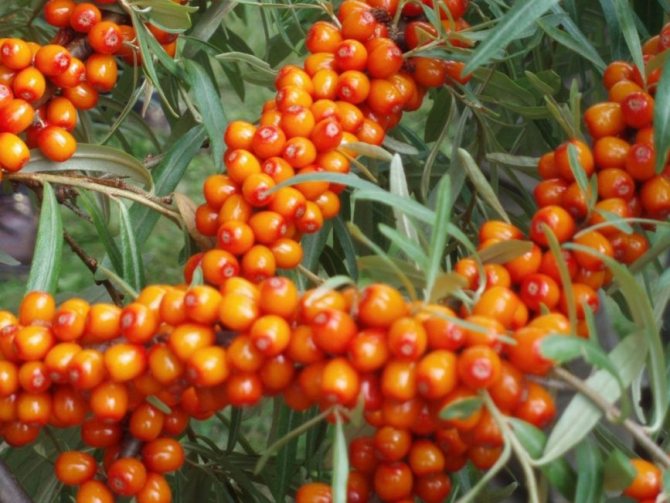

Moscow beauty The sea buckthorn variety is compact in size, perfect for small areas. It will bear fruit abundantly, and it will not take up much space. On average, about 15 kg of berries are harvested from each bush already 4 years after planting, while the Moscow beauty is not demanding on care and soil, it tolerates the winter cold well, has a strong immunity to most diseases that affect the inhabitants of the garden.
The characteristic features of the trunk are:
- the leaves of the variety are medium, with a green color on top and bluish on the bottom
- there are practically no thorns on the plant
- berries are large, when mature they have a bright orange color
- there are many fruits, when ripe, the branches almost completely turn orange
- fruits easily detach from the stalks when harvesting
- harvested berries perfectly tolerate transportation, can be kept fresh for a long time if the necessary conditions are created
The stem is simple to care for, it is enough to periodically clear the crown and feed the shrub with organic matter once every couple of years.
back to menu ↑
See also: Sea buckthorn: description, cultivation, useful properties and contraindications, treatment, preparations for the winter - a symphony of benefits and taste! + Reviews
Chuiskaya
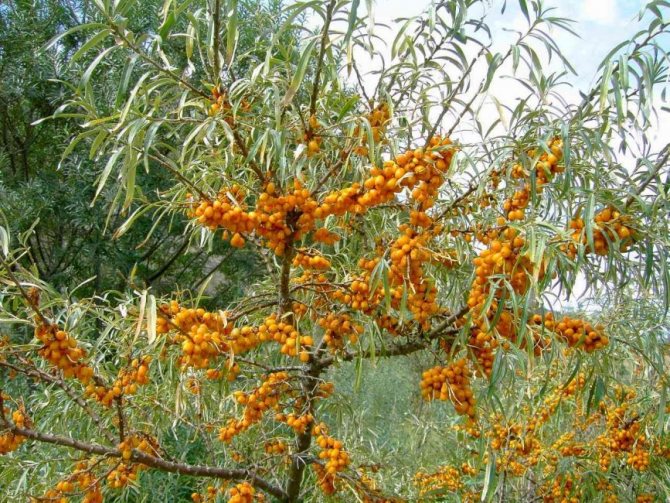

Chuiskaya The sweet and sour taste of ripe berries favorably distinguishes this variety of sea buckthorn among other boles with high yields. The crown of an adult tree is quite rare, it lends itself well to formation, which helps with harvesting. Thorns are completely absent, this is an additional plus for the variety.
Ripening takes place in the summer, the fruits are large, juicy, removed from the branches without stalks. Under normal conditions, 10-12 kg of berries with excellent taste are harvested from each adult stem. The harvested crop perfectly tolerates transportation, is used both fresh and processed.
back to menu ↑
See also: Gooseberry: a description of the 20 best varieties with photos and gardeners' reviews about them
Beloved
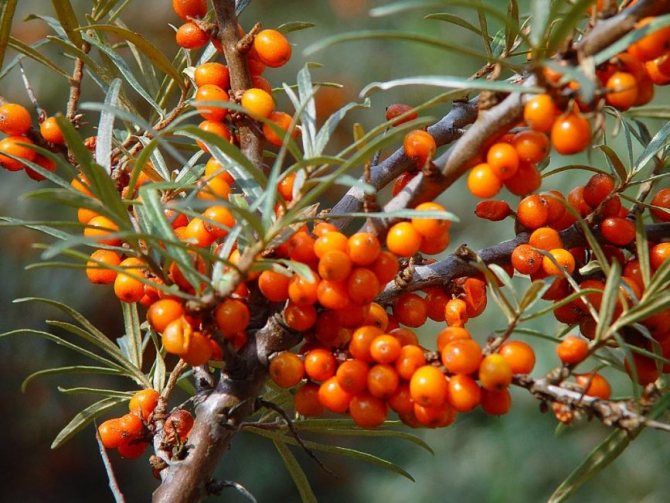

Beloved Another representative of high-yielding varieties is Lyubimaya sea buckthorn.
It is distinguished from other boles by the following indicators:
- shrub is of medium size
- crown shape is flat, slightly oval
- branches are straight, practically without thorns
- the leaves have a color characteristic of sea buckthorn, the top is bright green, the bottom is silvery
- oval fruits, large
- bright color will not allow anyone to pass by ripe berries
Harvested from the end of August, most often the berries are used for preservation for the winter and the manufacture of sea buckthorn oil, since the pulp is very loose.
The stem perfectly tolerates severe frosts, does not respond to most diseases that affect fruit trees in the garden.
back to menu ↑
See also: Persimmon: description and characteristics of the 9 best varieties. Early and late varieties (20 Photos & Videos) + Reviews
Nivelena
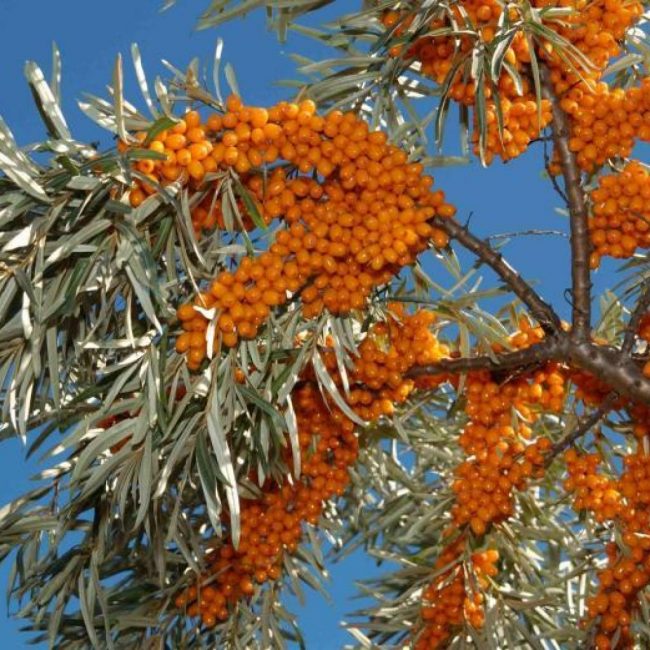

Nivelena Nivelena cannot be confused with other varieties already in appearance of the trunk, its crown is thin and has the shape of an umbrella. The branches are brown, dull, thorns are present in small quantities.
The variety will perfectly tolerate the harsh Siberian winters, it is not afraid of pests and diseases of this region.
The general description of the trunk is as follows:
- during the ripening period, the berries turn orange, typical for sea buckthorn
- fruits are large, spherical, with excellent taste
- the leaves are small in size, have a color characteristic of the plant
The harvested crop will perfectly transfer transportation over long distances, it will be kept fresh for a long time, subject to the necessary conditions.
Each of the varieties described bears fruit abundantly with proper care. Periodically, the trunks need to be rejuvenated, carefully remove old, dry branches, leave strong and young shoots.
back to menu ↑
See also: Hunting belt for fruit trees from garden pests: description, types of belts, DIY making + Reviews
Courtship
Sea buckthorn responds well to loose, weed-free, moist soil. Therefore, we surround her with care. Be sure to water, loosen, field, feed, clean the crown, save ourselves from pests and sores.
We water it once in early June (ovary growth), then in July. If the weather is dry when the berries are being poured, and there is not enough watering, then the harvest of berries may be small or even crumble ahead of time.
To avoid this, with the help of a hoe, we form a kind of "saucer" near the plant and carry out the third watering - 3-5 buckets of water. After saturation of the soil (water has been absorbed), sprinkle with dry soil.
Do not forget to weed in the trunk circle, thereby protecting the soil from weeds. We carry out loosening, deepening no more than 5 cm.The main thing is not to damage the roots that have grown close to the surface.
The distance between the bushes is best sowed with lawn grass, which, as it grows, mow.
Which seedling to buy
Requirements for the purchased seedling:
- In the presence of at least three skeletal roots up to 20 cm and a large number of small root processes;
- A trunk with a minimum height of 35 cm, a maximum of 50 cm, a trunk diameter of at least 6 cm;
- The presence of shoots on the trunk;
- Elasticity of the bark without damage or wrinkling;
- The bark does not flake off, and the wood under the bark does not have a brown tint (if it does, it means that the plant is frostbitten).
- The fewer thorns on the sea buckthorn, the better the variety. The absence of thorns is also a plus.
- It is enough to have 4 female sea buckthorns and one male pollinator on the site, so that the sea buckthorn is enough for five people for the whole year.
- If there is already a male in the neighboring garden and there are less than 10-12 meters between the plants, it is enough to plant only a female plant.
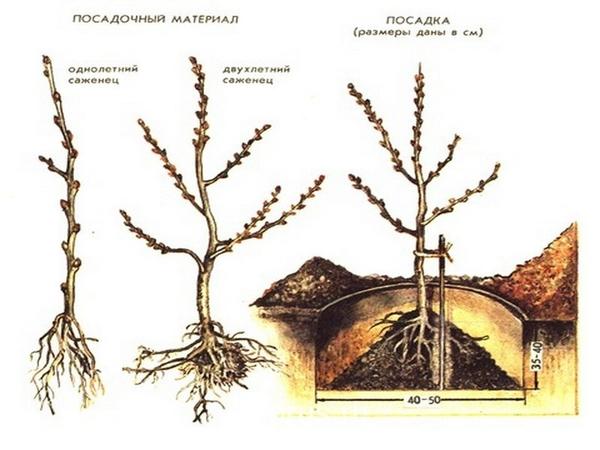

The most frost-resistant varieties
Sea buckthorn belongs to Siberian plants, therefore good frost resistance is its natural characteristic. But there are varieties for which this indicator is at the highest level.
Ear of gold
A sea buckthorn variety that begins to bear fruit as early as the 3rd year of life. You can also distinguish a small number of thorns. Berries of golden-orange color weighing up to 0.5 grams are collected in dense cobs... The main advantage is increased winter hardiness.
Trofimovskaya
Tall shrub with a spreading, umbellate shape. Bears large fruits weighing up to 0.7 grams of orange color with red tints... The shape of the berries is elongated. The variety is distinguished by a high content of ascorbic acid. Trofimovskaya is able to survive not only the winter cold, but also the spring frost, which are more destructive for most crops.
Botanical amateur
The shrub grows up to 4 meters in height, the crown has a pyramidal shape. The leaves are large, light green in color, the thorns are practically absent. The berries ripen at the beginning of August, and if the harvest is not harvested on time, it will overripe and become not transportable. Fruits are large, yellow-orange with scales. The shape is oval-cylindrical. The pulp has a pleasant taste and pineapple aroma. Also the variety is very productive, 15 kilograms of harvest are harvested from one bush, sea buckthorn begins to bear fruit already at 3-4 years of age... Botanical amateur is resistant to frost, drought and various diseases.
Gift of Katun
The bush grows up to 2.7 meters in height, the crown is oval, the thickening is average. There may be a small number of thorns, or they may be completely absent. The leaves are concave, deep green. The fruits are orange in color and round in shape, their average weight is 0.7 grams ... The crop can be harvested in the second half of August. Fruiting of sea buckthorn begins at 3 years of age and continues until 12 years of age. 14-16 kilograms of harvest are harvested from one shrub. The variety is resistant to frost and disease.
Sea buckthorn contains a large amount of vitamins and minerals, therefore, such berries have a beneficial effect on the human body. Due to its high oil content, this culture is often used in cosmetology.
Gardeners exchange opinions on the best varieties of sea buckthorn. This culture is interesting as a source of vitamin berries and healthy oils. Breeders develop varieties and hybrids for different regions. The characteristics of the plant are constantly being improved. And gardeners can choose the tree that will bear fruit in this particular area.
But before buying, it is recommended to study the technical data of sea buckthorn and correlate them with the local climate. Competent selection of the species will ensure annual fruiting.
Lemon Green Sea Buckthorn
Along with orange and red berries, sea buckthorn can have lemon green fruits. Such a plant looks exotic.
Herringbone
This variety is interesting for gardeners who are interested, in addition to the harvest, the decorativeness of the planted plants. The shrub looks like a small Christmas tree. Plant height - 1.5-1.8 m. The shrub has a dense and compact crown. There are no thorns.
The variety is obtained by exposing seeds to chemical mutagens. It is under trial. Herringbone is not a stable form and can mutate. Pros - resistance to mycosis, cold weather, does not give overgrowth.
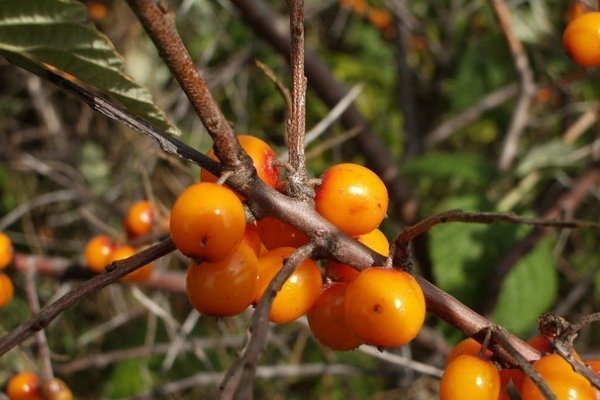

Sea buckthorn pests
The most dangerous pests for sea buckthorn are:
Sea buckthorn moth - its caterpillars penetrate the kidneys during their swelling and eat them out from the inside;
Control measures. The best way to get rid of moths is to treat sea buckthorn with a solution of Karbofos during the period of swelling of the kidneys;
The sea buckthorn fly is the most dangerous pest for the plant, capable of destroying the entire crop. Flies fly out in the second half of June. Their larvae eat into the berries and destroy the pulp of the fruit, from which they wrinkle, darken and fall off.
Control measures. You can get rid of the sea buckthorn fly by treating the sea buckthorn in mid-July with a solution of Chlorophos;
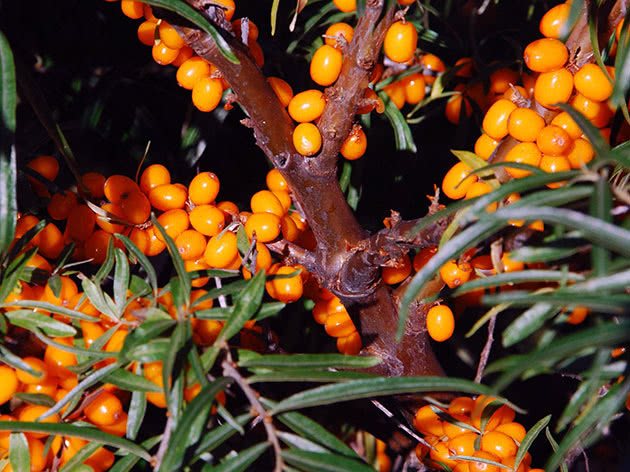

Sea buckthorn aphid is a sucking insect that feeds on the juice of leaves and young shoots, settling on the underside of the leaf plate, which makes the sea buckthorn turn yellow, its leaves curl and fall off prematurely.
Control measures. If aphids proliferate, folk methods of struggle, such as processing with infusions of onion husks or garlic, tobacco leaves with laundry soap, may not give results, and you will have to resort to insecticides - treating sea buckthorn with a ten percent solution of Karbofos during the period of foliage blooming;
Sea buckthorn gall mite is a very small pest that sucks juices from young leaves of a plant, from which they swell, deform and fall off.
Control measures. With gall mites, the same methods of control are effective as with aphids.
In addition to the pests described, with insufficient care for sea buckthorn, you may encounter other pests, but if you follow the agricultural practices, the diseases and pests of sea buckthorn will bypass your garden.
Harvest varieties
Gardeners prefer to plant fruitful species. The presence of 3-4 female sea buckthorns will provide the whole family with valuable raw materials.
Botanical
Sea buckthorn from Altai. Further work was carried out in the Botanical Garden of Moscow State University. Characteristics:
- large fruits;
- the skin is bright yellow, shiny, dense;
- the yield increases with the age of the sea buckthorn;
- excellent transportability;
- high frost resistance of the plant.
The fruit received a high taste rating: 4.5 out of 5 points.
Chuiskaya
An excellent product of Siberian breeders. The variety is over 40 years old, but is still popular. Characteristics:
- few thorns;
- yield up to 20 kg / plant;
- the skin is dense;
- the pulp is juicy, aromatic;
- transportability is excellent.
The variety has become widespread throughout the territory, it takes root well and bears fruit everywhere.
Nivelena
The species pleases with a yield of 10 kg / bush. The plant is characterized by high winter hardiness, disease resistance. Ripens in August.
The largest varieties of sea buckthorn, description
Sea buckthorn, growing in the wild, bears fruits weighing 0.2-0.3 grams, the weight of berries of cultivated plants is 0.5 grams. But there are varieties that are capable of producing fruits, the mass of which reaches 1.5 grams.
Openwork
This tree has a beautiful, spreading crown, there are no thorns on the branches. The fruits are bright orange in color, resembling a cylinder in their shape. The weight of one berry reaches 1 gram. Sea buckthorn of this variety ripens early and gives a bountiful harvest.... It is resistant to frost, drought and many fungal diseases.
Augustine
Fruits of this variety weigh about 1.1 grams and are orange in color and ovoid in shape. The fruits are collected in loose clusters, which greatly simplifies the process of their collection.... A small number of thorns are present on the shoots. Sea buckthorn ripens early, 16-18 kg of harvest is harvested from one adult tree.
Elizabeth
A shrub with a neat, compact crown that does not require lengthy pruning. On average, the berries weigh 0.9 grams, have a sweet and sour taste with light hints of pineapple. Fruits grow on long stalks, easily detachable from the brush, ripen at a later date... Among other things, the variety is distinguished by high winter hardiness and resistance to pest attacks.
Essel
The variety is a novelty of Siberian breeding. Berries have excellent characteristics, their weight reaches 1.2 grams, oval shape, sweet taste, dessert. Fruits ripen in August, are characterized by weak attachment to the brush.
Low-growing varieties
Gardeners are attracted by species of sea buckthorn with a small habit. Such species take up less space, and in regions with strong winds, the crown is less damaged.
Low bushes are easy to care for, and harvesting does not turn into an unsolvable task.
Galerit
The fruits ripen at a later date. The berries are bright orange, large. The pulp has a characteristic bitter taste. The yield reaches 10 kg / bush. But gardeners are not satisfied with the thorns on the branches.
Thumbelina
Low-thorn bushes, height rarely exceeds 1.5 m. Productivity is high: up to 20 kg / bush. The variety is resistant to drought and frost. But the fruits are poorly transported and stored little.
Bayan-Gol
The gardener will receive the first crop 2 years after planting. The height of the bush is 1.2 m. The skin of the fruit is dense, the pulp is juicy, sweet and sour. The transportability of the berries is excellent. The plant is resistant to frost and drought. But the yield rarely exceeds 5 kg / bush.
Ryzhik
Heavily studded variety. The berries are bright orange and sour. Productivity is high: up to 19 kg / bush. The fruits ripen in medium terms.
Landing rules
Subject to the general planting norms, you can grow sea buckthorn and get a harvest of medicinal berries. To do this, determine the timing of planting a plant, properly prepare a place, a planting pit, study the technology and know the scheme for planting sea buckthorn seedlings.
Timing
It is recommended to plant sea buckthorn in summer and spring in late March - early April. Planting at this moment will allow the plant to adapt to the conditions and have time to get stronger before the cold comes.
For sea buckthorn seedlings with a closed system, planting in the fall is optimal. Its dates range from late September to October. Planting is carried out after leaf fall, allowing the young plant to spend its strength not on a natural process, but on survival in a new place.
Site preparation and planting pit
Site preparation consists in digging the ground and removing the rhizomes of perennial weeds. It is also necessary in advance to dig a planting hole measuring 50 x 60 x 50 cm and add compost, humus, mineral fertilizers to it.
If the soil is acidic, add lime or ash.
In the presence of heavy loamy soil, it is imperative to lay drainage at the bottom of the hole and enrich the soil with fertilizers such as sand, peat.
Sapling planting technology and schemes
Even for a novice gardener, planting sea buckthorn will not be difficult. Planting a plant in a garden involves performing the following actions:
- At the bottom of the prepared hole, form a hill by filling the hole 1/3 with the soil mixture.
- Put a young seedling on a hill, carefully spreading the roots, cover it with soil, slightly compacting it. To deepen the root collar by 5-7 cm, this will provoke the formation of additional roots.
- Place a wooden peg next to it for secure support and tie the seedling to it.
- Water at the rate of 2 buckets of water per plant.
- Mulch the soil around the trunk of the plant using sawdust, peat.
Care
It is not difficult to care for this shrub. It is important to loosen the ground, water and feed the plant, and remove dried shoots. And then the sea buckthorn will bear fruit for about 12 years.After reaching the time when the tree stops bearing fruit, you can cut it down to a stump, this will give an incentive to grow new shoots, which will again bear fruit in the future.
Watering
Sea buckthorn loves watering, especially in the heat. When picking berries, we recommend watering the sea buckthorn well and rinsing the berries on the branches in one.
Top dressing
You need to feed 4 times a season:
- the first time it is done in the spring.
- the second time during flowering, it is done with a potassium humate solution.
- the other two dressings are carried out after flowering, with an interval of 20 days, for this use Effekton.
Pruning
An important condition for leaving is to trim the tops. This promotes good crown development. You need to prune before bud break in order to remove unnecessary, damaged branches and root shoots. This can be done at harvest time. The tree can grow up to 6 meters, for easy harvesting it is important to regularly prune the tops. This is done with a sharp garden knife or pruner.
For preventive purposes, three-year branches are cut off.
Reproduction
To increase the number of sea buckthorn trees in the garden, there is no need to buy seedlings, there are many methods of crop propagation:
- using seeds;
- using root suckers;
- layering;
- using green, lignified cuttings.
Gardeners choose an acceptable option for themselves. All methods require a little time and effort, but at the same time, it is a pleasant and useful event, which, as a result, will delight you with a harvest of valuable and irreplaceable berries in the household.
Red sea buckthorn
For sea buckthorn, red berries are rare. Even after breeding work, there are very few red-fruited varieties.
Rowan
Shrubs with narrow pyramidal crowns. Collection from a bush - up to 6 kg. There are rare, single thorns that complicate the harvest.
The variety is mid-season. The berries are dark red in color, with shine. The fruits are fragrant, there is a bitterness. Resistance to fungal diseases.
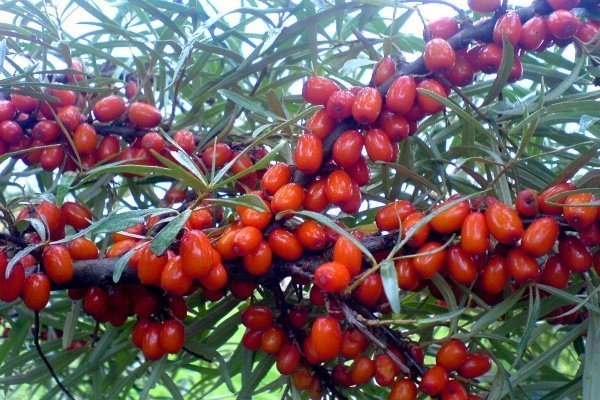

Siberian blush
Shrubs with narrow, pyramidal crowns. Harvest from a bush - up to 6 kg. There are rare, single spines.
The variety is mid-season. The berries are dark red in color, with shine. The fruits are fragrant, with a bitter taste. Resistance to fungal diseases.
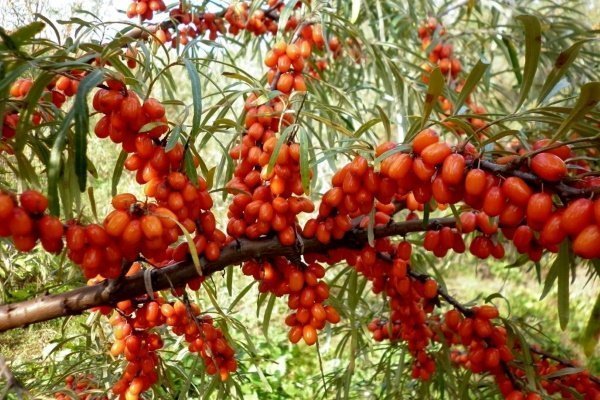

Krasnoplodnaya
Plants are vigorous, spreading, thorns along the entire length - because of them, collection is difficult. Crohn's is weakly pyramidal. One bush gives about 5-6 kg of berries.
Early variety, with red fruits, sour, delicately aromatic. Weight - 0.6 g. Taste - mediocre. Fruits for technical purposes. Frost resistance - medium.
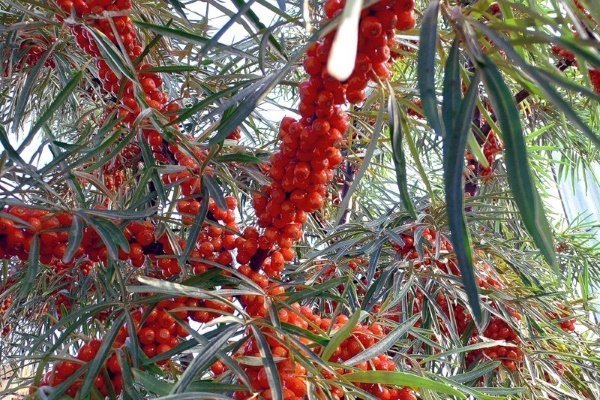

Red torch
Shrub of medium height, slightly spreading crown. Average yield - about 6 kg per bush. Shoots are covered with a few thorns.
Late-ripening variety. Withstands frost down to minus 40 ° С. It rarely gets sick and staunchly resists pests. The fruits are red in color with an orange tint. Weight - 0.7 g.
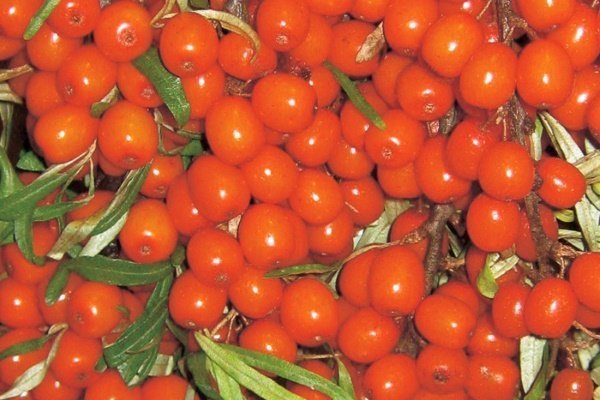

Cooking a place
Planting can be organized around the perimeter of the garden, in a circle, in a checkerboard pattern, etc. You can generally plant it on the lawn in front of the house, then it will play the role of not only a berry, but also an ornamental plant. The main thing for any landing option is to adhere to a distance between them of at least 2 m.
One male plant is capable of pollinating 5-7 females. Due to the fact that, in general, we do not have very large areas and there is no opportunity to settle a large number of bushes, one male and two female ones are quite enough.
Since male plants are prone to death, it would be good to get two male plants of different ages. Plant one with the women, and the second after 3 years, thereby insuring yourself against the death of the other.
Since autumn we have been preparing the landing site.
Since we plant several crops at a time, we organize a continuous digging of soil with the addition of 12 kg of humus / compost, 200 g of simple superphosphate, 20 g of potassium sulfate plus 50 g of "Agricola for berry crops" per m2.
We prepare the planting pit itself, filling it with the following composition - we mix the fertile soil, adding 2 buckets of humus, compost, 300 g each of superphosphate, lime-fluff, 50 g of potassium sulfate, 100 nitrophosphate. For heavy soil, you will need more sand - 4-5 buckets.
Early maturing varieties
For people who want to enjoy the harvest early, early maturing varieties have been created. Sea buckthorn is saturated with vitamin C, ripens by the border of July and August, at the latest - at the end of the first August decade.
Minusa
A plant with a height of three meters with a spreading crown of medium density. Harvest - 15-24 kg of fruits. The collection is facilitated by the complete absence of thorns. The fruits are large (0.7 g), sweet and sour, and look like yellow-orange cones. Good resistance to severe cold and fusarium.
Botanical amateur
Sea buckthorn Botanical amateur - early maturing shrub under 4 meters with a pyramidal crown and few thorns. Yields 7.5 - 14.5 kg of berries. They are large (up to 0.85 g), elongated-oval, orange-yellow hue. They are resistant to cold weather and disease, but the crop is harvested immediately: it instantly overripe, which affects transportation. The variety was bred for the northern regions, including the Moscow region. Botanical aromatic sea buckthorn also belongs to high-yielding. She has the same coloration, but with a red speck on top. The yield is good, up to 15 kg per bush. The berries are smaller and can be transported without problems.
Classification of varieties by maturity
The breeders divided the sea buckthorn into groups according to the ripening time of the berries. Plants bear fruit from late July to late September.
Early ripe
In varieties and hybrids of this group, berries can be harvested at the end of July. They have a high content of acid and vitamin C. Ripening ends in the first half of August.
Mid-season
These types of shrubs delight with the harvest from late August to early September. These berries have a sweeter taste.
Late ripening
Late ripening sea buckthorn has a balanced fruit flavor. The amount of sugars and acids is optimal.
Diseases of sea buckthorn
For some reason, it has always been believed that sea buckthorn is little affected by diseases, however, along with the spread of this culture in our gardens, it turned out that such a statement has no basis. Sea buckthorn, like other fruit trees, is affected by fungal, viral and bacterial diseases. Most often, sea buckthorn suffers from diseases such as:
Endomycosis is a focal fungal disease that manifests itself in early August on sea buckthorn fruits, which become flabby, soft and filled with odorless gray mucus. The shell of the affected berries breaks through, and the contents flow out onto neighboring berries, infecting them with endomycosis. Rain and dew contribute to the development of the disease.
Control measures. Sea buckthorn treatment consists in a two-stage treatment with one percent Bordeaux liquid or copper oxychloride. The first treatment is carried out after the end of flowering, and the second in mid-July;
Black cancers appear as dark, round spots on large branches. With the development of the disease in the places of these spots, the bark turns black, becomes covered with cracks and falls off, the wood darkens and rots. The causative agent of the disease penetrates the places of frostbite or wounds during pruning.
Control measures. The affected areas are cleaned from diseased bark and wood to healthy tissue, treated with copper sulfate, and then a mixture of clay with mullein;
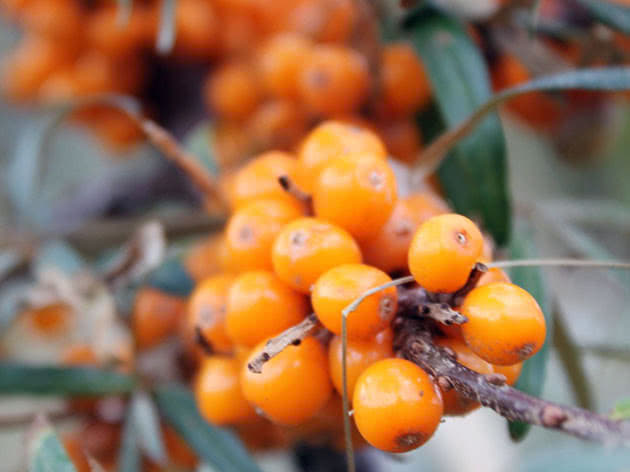

The black leg, excited by soil fungi, thinns the stem of the seedling at the point of contact of the seedling's hypocotal knee with the soil. Young seedlings are affected by the disease.
Control measures. Grow the seedlings on a substrate of washed sand mixed with turf soil. For preventive purposes, water the seedlings with a pale pink solution of potassium permanganate once every few days, but if the disease still manifests itself, then treat them with a solution of potassium permanganate daily:
Scab, or stegmina, is a fungal disease that affects young shoots, leaves and fruits, often leading to the drying of the shoots, or even the entire plant. In the middle of summer, black, round, shiny spots are formed on the berries, gradually increasing in size. Then, pink or yellow mucous formations appear through the ruptures of the fruits. The fruits dry up and turn black. Black swellings appear on the shoots of the current year, black velvety spots and ulcers appear on the leaves. The bush looks like it has been sprayed with black ink.
Control measures. As a preventive measure, every autumn, carry out a sanitary pruning of sea buckthorn, after which burn all plant residues, and treat the sea buckthorn with one percent Bordeaux liquid no later than 20 days before harvest;
Gray and brown rot - these diseases appear in July, and rainy weather contributes to their development. From gray rot, the fruits of sea buckthorn shrivel and wither, and from brown, dark spots appear on the berries.
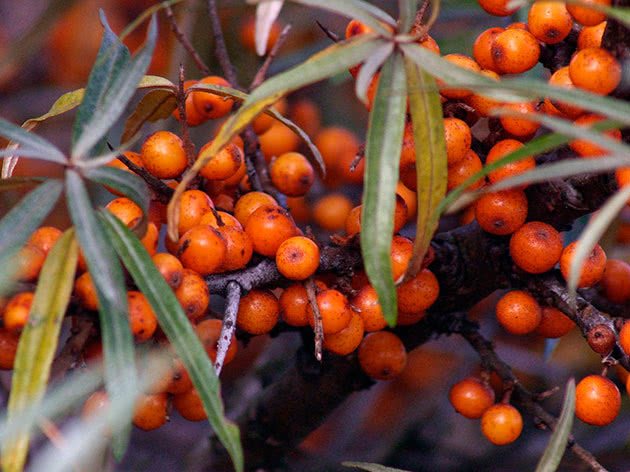

Control measures. Plants showing signs of disease are cut and burned. As a preventive measure, the rules for caring for sea buckthorn are strictly observed - watering, loosening the soil, feeding.
In addition to the diseases described, sea buckthorn can be affected by fusarium, verticilliasis, alternaria, phomosis, terry sea buckthorn, annular necrosis of branches and corineum necrosis, mixed and heart-shaped rot of the trunk, however, if you follow the agrotechnics of sea buckthorn, you may never know what the symptoms of these diseases look like.
Mid-season varieties
The berries of mid-season varieties ripen in the second half of August or early autumn.
Chanterelle
Bushes of medium height with a slightly spreading crown. The variety is fruitful - up to 15-20 kg of berries can be removed from the bush.
The berries are large, cylindrical, reddish-orange in color. Thick-skinned fruit, sweet and aromatic. Highest score on the tasting scale. The fruits are universal, there is a lot of C-vitamin. Berry weight - 0.8 g.
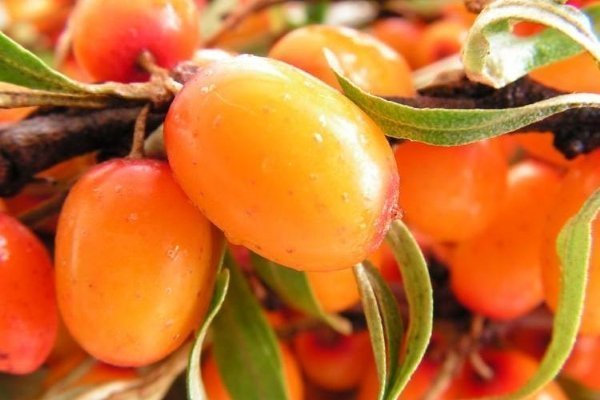

Bead
The crown is spreading, the shrub is high. The shoots have medium-sized thorns. Harvest per bush 13.5-15 kg.
The berries are round, truncated-conical. The color is rich orange. Weight - 0.5 g. The berries taste sweet and sour. There is a refreshing scent. Drought tolerant.
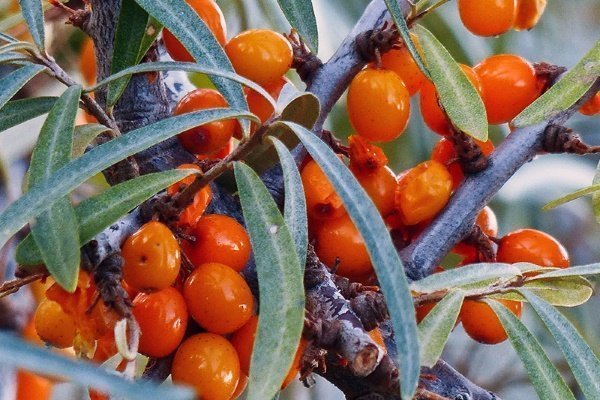

Nivelena
Medium-sized shrubs. Crohn - umbrella-shaped, weak spreading. Thorns are rare and thin. About 10 kg of berries are collected from the bush.
Fruits weigh 0.5 g, yellow-orange, round. The taste is sour, aromatic. Do not choke during transportation. Excellent winter hardiness.
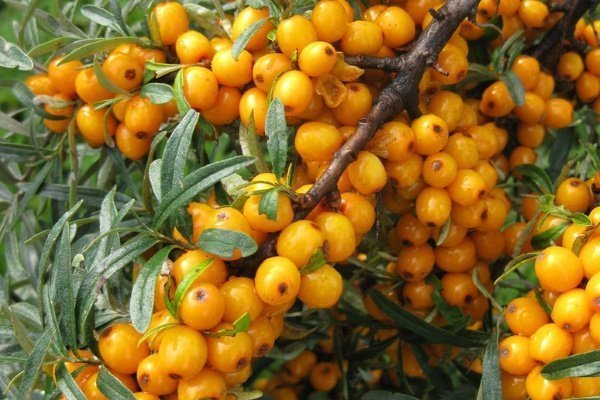

Bonfire
A medium-sized shrub with a slightly spreading crown. Shoots are not pubescent. Harvest per bush - 7-8 kg.
Mid-season, frost-resistant variety with red-orange, elongated fruits. The berries are sweet and sour, refreshing. The fruits are universal. Weight - 0.7-0.9 g.
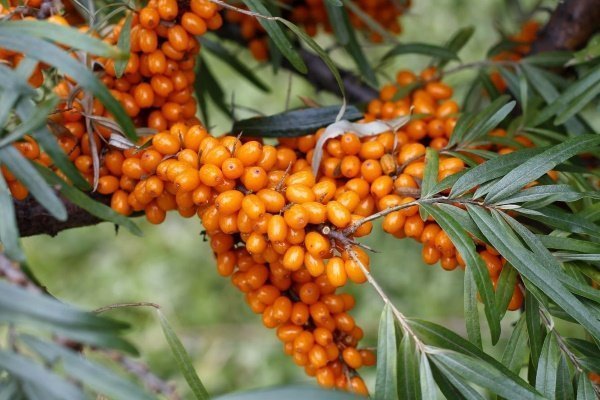

Varieties for different regions
The height and shape of this plant is very diverse - it can be a single-stemmed powerful tree, or it can be a dense thorny shrub. In this matter, it all depends on the variety.
There are three main types:
- Tibetan - a squat shrub with a thick winding trunk and short leaves, growing in the highlands of the Himalayas and in China.
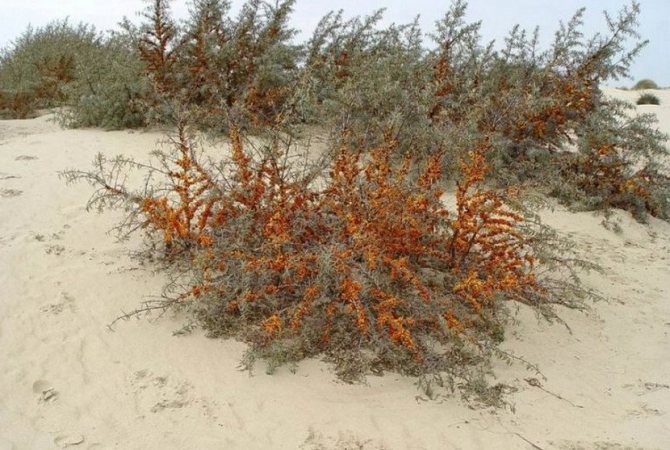

- Willow - a tree 5–11 m high with rather long and wide leaves, common on the southern slopes of the Himalayas.
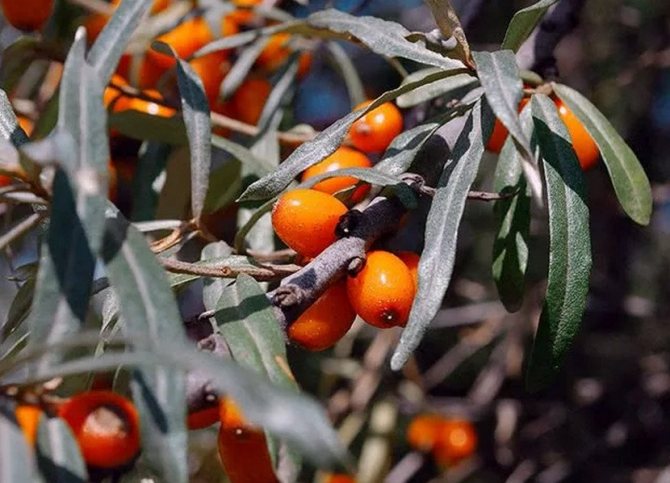

- Buckthorn - a dioecious deciduous shrub 1–6 m in height with many different forms.
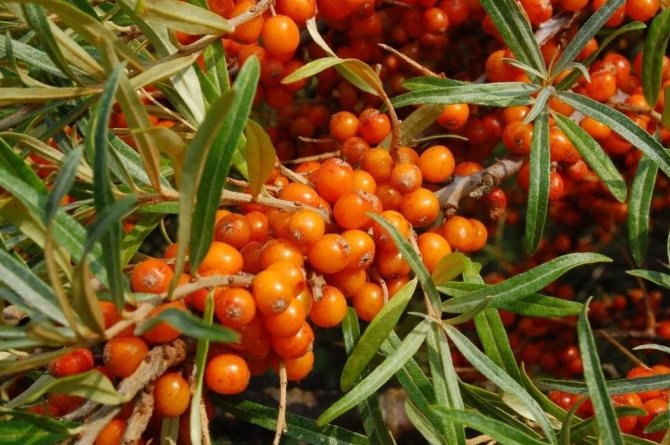

Sea buckthorn grows on the territory of Russia. The vast area that it occupies testifies to its unique ability to adapt to the most diverse growing conditions in any climatic zone. However, it is possible to classify varieties, taking into account, first of all, their temperature preferences in the area where they grow.
Separate groups are focused on different regions:
- Siberia.
- The middle lane and the Moscow region.
- Northwest Russia (Leningrad Region).
- Karelia.
- Ural.
- Southern regions of Russia (Krasnodar Territory).
The best varieties of sea buckthorn for central Russia
For central Russia (as, indeed, for the Moscow region), sea buckthorn varieties of the European selection direction are well suited. Despite the rather mild climate, winters here are often harsh and not very snowy, and summers may well be dry and hot. European varieties tolerate sharp temperature changes better than Siberian ones.
Well established in this region:
- Augustine;
- Nivelena;
- Botanical amateur;
- Giant;
- Vatutinskaya;
- Vorobievskaya;
- Moscow pineapple;
- Rowan;
- Pepper Hybrid;
- Zyryanka.


Important! Resistance to fungal diseases in European varieties of sea buckthorn is usually relatively high, which is also very important for the climate of the middle zone.
How to care for sea buckthorn in the middle lane, how to feed it, what problems you most often have to face, the video will tell you in more detail:
How to fertilize
Sea buckthorn is not harmful in terms of fertilization. Due to the wide root system, it independently finds nutrients in the soil and there is no need to fertilize it for the first years.
If desired, for better formation of new shoots of the plant in the spring, you can fertilize sea buckthorn with urea (up to 30 g per 1 bucket of water). Each tree or bush is watered with half a bucket of liquid.
It is advisable to fertilize young growth with organic fertilizers. For example, stir humus in water and water the plant around. This procedure should be carried out once every three years.
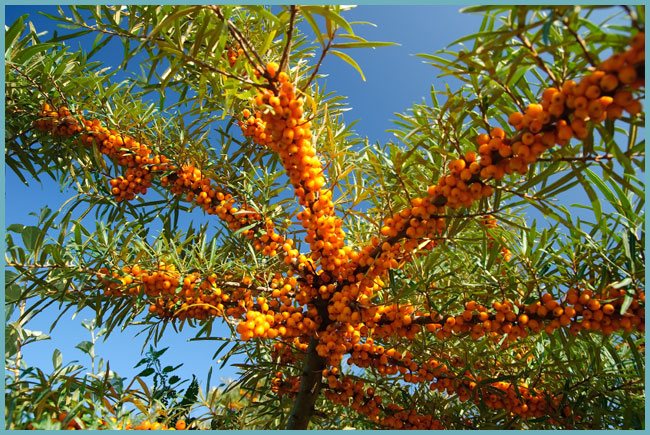

Sea buckthorn loves moisture, so it is worth watering it infrequently, but with plenty of water. Paying such attention to the plant, sea buckthorn will bring a good fruitful harvest every year and will not interfere with other plants with its roots. Get treated, enjoy the beauty of this plant and do not forget the peculiarities of caring for it!
What is needed for growing
In order for sea buckthorn to grow normally and bear fruit in the open field, it is necessary, if possible, to satisfy the biological requirements of the plant for the growing conditions.
Climatic conditions
Sea buckthorn grows in completely different climatic conditions - from Asia to Siberia. The plant is not afraid of severe frosts, and the culture is adapted to drought thanks to its powerful root system.
Location and illumination of the site
Sea buckthorn is a light-loving plant, therefore, the place for planting must be chosen sunny, in the shade its growth slows down, and the yield indicators decrease. Also, the culture must be protected from strong winds, which are detrimental to it. The plant will feel comfortable on the southern edge of the site, along the fence, buildings.
Suitable soil
Sea buckthorn loves neutral, alkaline soil. Inadmissibly close to the groundwater surface. It is better to lime acidic soil with slaked lime, and to combine heavy loamy soil for air permeability with sand, humus with the addition of substances such as superphosphate, potassium salt.
Favorable and unwanted neighbors
Medicinal herbs such as chamomile and oregano are considered good neighbors for sea buckthorn. This berry culture does not take root with raspberries, black currants, strawberries, since the roots of the plants are in the ground at the same level and will fight for moisture and nutrition. Unwanted neighbors for sea buckthorn are nightshade plants.
Choosing a landing site
Sea buckthorn is a big lover of light. Therefore, the crown should not be shaded by anything. The nutritional area of one plant covers 6 m2 - this must also be taken into account when choosing a place for growth. Hence the conclusion - when planting, it is important to maintain a distance between the bushes of at least 2 meters.
Prefers a light texture of the soil with necessarily good air circulation and water permeability. The neutral reaction of the soil will be very comfortable for her. In principle, with appropriate cultivation of the land (planting pit), it can grow on any soil, even clay.
The growth site should be protected from snow drifts.The twigs can break under the weight of the snow, and, accordingly, we will lose our harvest. After all, its fruiting occurs on the growth of the previous year.
The sweetest varieties
Sea buckthorn is traditionally sourish. But today, thanks to painstaking selection work, there are several varieties that are distinguished by increased sweetness. Such varieties are called dessert varieties - their fruits smell good and contain a lot of sugar.
Beloved
Shrubs of medium size with a spreading crown. There are very few thorns, they are scattered along the entire length of the branches. On the shoots - a whitish bloom. The leaves are silvery from the inside. One bush gives 7.3 kg of berries.
Bright orange, large berries ripen closer to September. Fruits of a classic, oval shape, are notable for their friability, they are used for preparing winter preparations and pressing sea buckthorn oil. The weight of one berry is 0.65 g. It easily tolerates severe winters and is not afraid of diseases traditional for sea buckthorn.
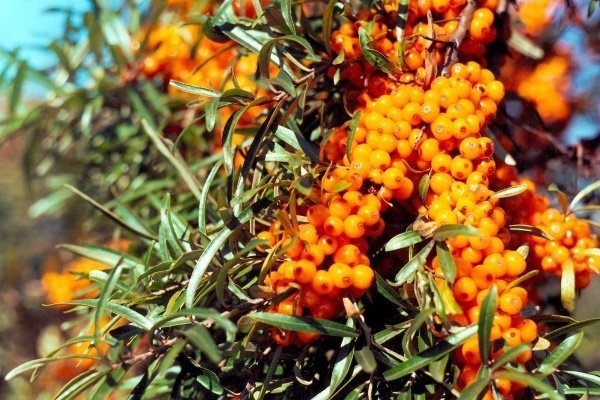

Digs
The plant is of medium height, the crown is compressed. The thorns are short, concentrated in the upper part of the branches. Up to 14 kg of fruits are collected from one plant. Loves the sun and needs to be fed with organic fertilizers. Tolerates moisture deficit. Preventive pruning is required annually.
The variety is early maturing and winter hardy. It grows and matures easily in Siberia. The berries are large, weighing about 0.6 g. Sweet and sour, orange berries have a rich taste and fresh aroma.
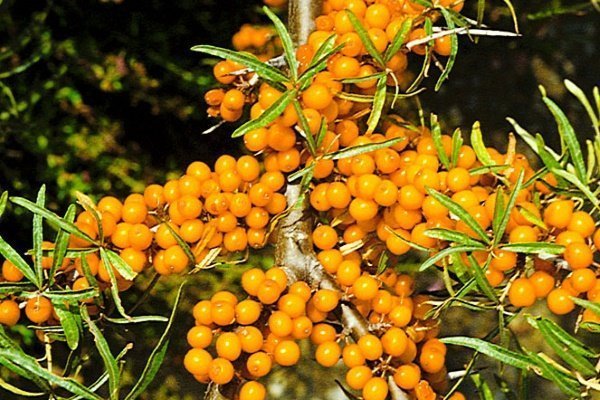

Tenga
The plant is average in all respects - in height, crown density and presence of thorns. One plant produces up to 14 kg of fruits.
A fast-growing, mid-season variety. The berries are large, weighing about 0.8 g. Orange berries have a bright, rich taste and fresh aroma. On ripe fruits - "blush". Resistant to sea buckthorn flies and ticks.
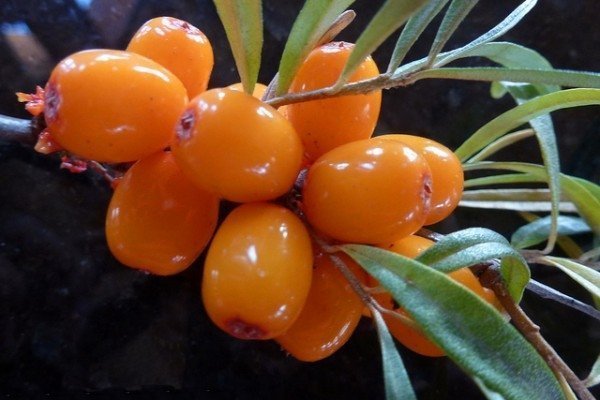

Muscovite
Plant height - 2.2-2.5 m. Compact pyramidal crown. Productivity - up to 10 kg. The appointment is universal. Dessert fruits, aromatic. There are thorns.
The berries are bright orange, thin-skinned, with reddish specks on the surface. Belongs to mid-season varieties, berries are harvested in early September. Fruits are dense, mature, transported without problems. Disease-resistant and frost-resistant variety.
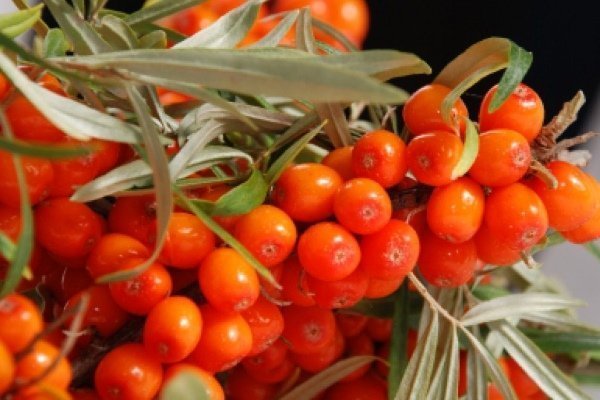

Everyone knows about the benefits of sea buckthorn, but this miracle berry also has contraindications - it cannot be used by people with urolithiasis, gastritis and gallstones.
Nizhny Novgorod sweet
The plant grows rapidly, of medium height, spreading crown. Leaves are dark green, large. Prefers the sunny side. The bush bears fruit for 2-3 years. 10 kg of berries are collected from the bush.
The variety belongs to the mid-season - the berries are ready for harvesting at the end of August. The fruits are in the form of cylinders, they are orange-yellow, sourish, large - 0.9 g. Easily torn off. This sweet sea buckthorn is suitable for any purpose, it is used not only for medical purposes, but also for the preparation of various delicacies - jams, compotes, jellies, jelly, sweets, wines.
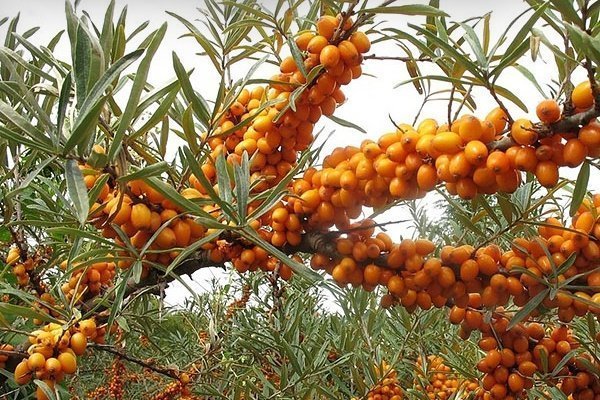

Moscow pineapple
Bushes of medium height, with a compact crown. One plant brings owners up to 16 kg of sea buckthorn. There are at least thorns. The berries have a specific aroma reminiscent of the smell of pineapple.
Belongs to the mid-ripening category, the berries ripen by mid-August. They are pear-shaped, medium-sized, weighing no more than 0.6 g. The color is dark orange, with a red spot on the top. Endures frost without damage. Resistant to common diseases. Fruits for universal use, transportation does not cause spoilage.
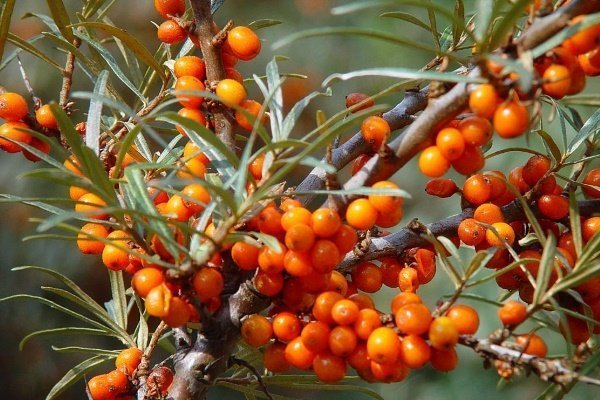

Claudia
Self-fertile variety - not capable of self-pollination. Treelike bushes of medium height, the crown is flat-rounded, spreading, density is medium. One shrub gives up to 10 kg of sea buckthorn. The spine is weak. Fruiting begins at the 4th year of planting.
The berries are cylindrical, bright orange, large - 0.8 g. The berries come off easily. The taste is dessert. Suitable for any processing. The variety is not afraid of cold weather, viruses, and is not damaged during transportation. Used for freezing. Good resistance to sea buckthorn fly.
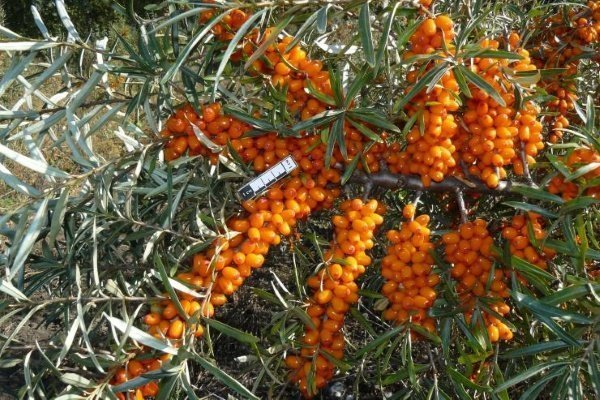

Content
- Description
- Planting sea buckthorn When to plant
- Planting in spring
- Planting in autumn
- Spring care
- When to trim
- How to propagate
- Beneficial features
Orange sea buckthorn
Most of the sea buckthorn varieties have bright orange fruits - it is from them that this plant is recognizable. However, orange is not the only color for sea buckthorn berries.
The lights of the Yenisei
Bushes are tall, spreading, yield 8-9 kg of berries. There are thorns, but they are located only at the bottom of the shoots. Spines are short and few in number.
Early variety. Berries weight - 0.6 g. Fruits of traditional orange color, have a pleasant refreshing aroma and sweet and sour taste. Resistant to drought, frost, disease.
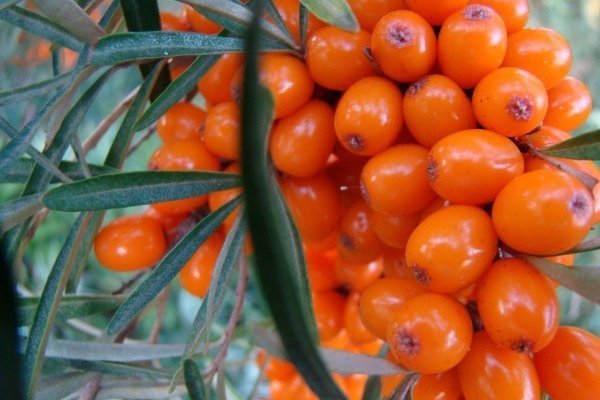

Sayan
The bush is of medium height, compact. There are few thorns. One plant produces 11-16 kg of berries. Bears fruit in the 3rd year.
Mid-early sea buckthorn. Fruits are medium, orange in color, reddish tops. Does not suffer from fusarium. The taste is sour. The berries are thick-skinned.
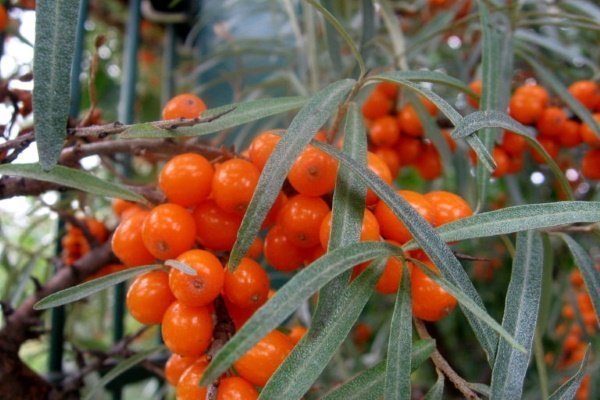

Ayaganga
Large-fruited variety with compact, medium-sized bushes and moderate foliage. The crown is rounded. One plant produces 8-11 kg of berries.
The berries ripen in the second decade of September. Drought resistance - medium. Medium-sized orange fruits - weighing 0.55 g. The shape is barrel-shaped. The taste is excellent. They are distinguished by high winter hardiness of flower buds.
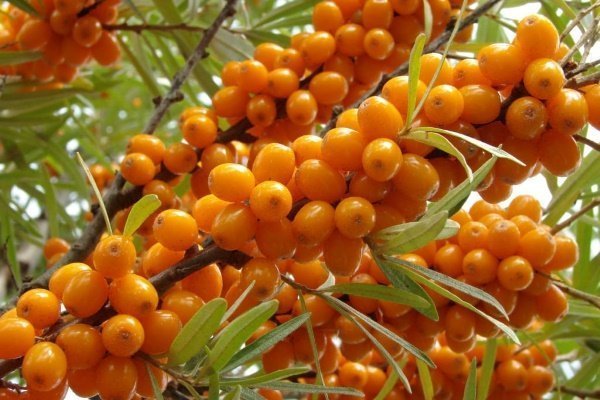

Sea buckthorn properties - harm and benefit
Useful properties of sea buckthorn
Not only sea buckthorn fruits have healing properties, but also its leaves and branches. Sea buckthorn contains oxalic, tartaric and malic organic acids, vitamins C, B1, B2, PP, K, E, carotene and carotenoids, flavonoids, manganese, boron and iron, tannins, phytoncides, oleic and linoleic fatty acids.
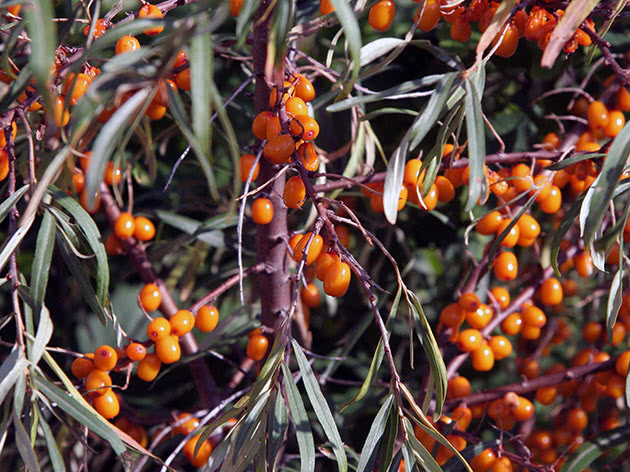

Sea buckthorn fruits contain serotonin, which is of great importance for the normal functioning of the human nervous system, as well as beta-sitosterol, which has an anti-sclerotic effect. A decoction of sea buckthorn berries is indicated for stomach and duodenal ulcers. Applying fresh berries to treat frostbite, burns and abscesses. For men over forty years old, sea buckthorn berries are shown as a means of increasing potency.
The leaves and fruits of sea buckthorn remove oxalic and uric acid from the body, the infusion from the leaves of the plant is used in the treatment of gout, rheumatism and diabetes mellitus. A decoction of the leaves and branches of sea buckthorn is prescribed for disorders of the gastrointestinal tract. Dry leaves are brewed like tea for scurvy symptoms.
But, perhaps, the most valuable product is sea buckthorn oil, which has the strongest bactericidal effect. It contains vitamin E, vitamin F, which regulates the metabolism of the skin, sterols, trace elements and minerals silicon, silver, copper, vanadium, nickel, manganese and cobalt. Apply oil both externally and internally. Its action increases the amount of protein in the liver, improves lipid metabolism, and stimulates regenerative processes in damaged tissues.
Sea buckthorn oil for chronic pharyngitis and laryngitis is used to lubricate the mucous membrane of the oral cavity, it is used for inhalation. Dermatologists recommend using sea buckthorn oil to enhance hair growth caused by certain skin conditions.
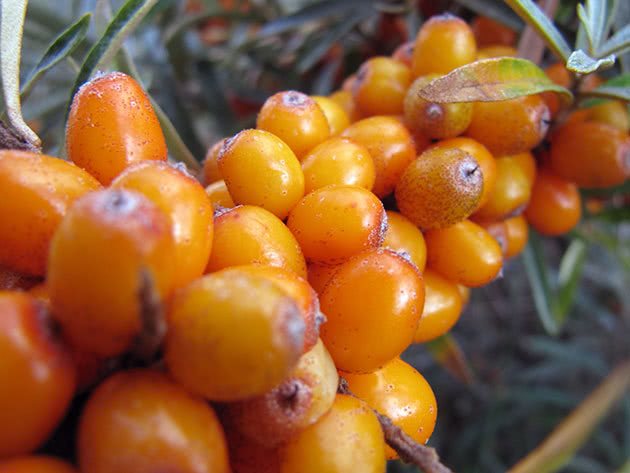

Preparations based on sea buckthorn oil can greatly improve the body's tolerance of anticancer drugs, and sometimes even enhance their therapeutic effect. To strengthen the immunity of the baby, nursing mothers are recommended to add a few drops of sea buckthorn oil to the baby's milk from one month of age.
Why sea buckthorn is useful: why is it worth growing?
Sea buckthorn is a plant that belongs to the Lokhovye family. A tree or a bush up to 10 m in height with a trunk covered with thorns, elongated foliage and healing fruits, which are actively used in medicine, cosmetology, traditional healers and culinary specialists benefit from them.
The beneficial properties of berries for health are due to their chemical composition, which makes them an invaluable aid in the treatment and prevention of various diseases. When using them, there is an improvement in health and a quick recovery, since:
- strengthen the immune system, increasing the body's resistance to colds and all kinds of infections;
- stimulate the work of the heart and blood vessels;
- lower the level of bad cholesterol in the blood;
- activate metabolism, optimize the activity of the intestines and the digestive system;
- slow down the aging process;
- improve mood and calm the nervous system, stimulate the brain.
This spectrum of useful properties makes sea buckthorn berries indispensable in the food menu, as well as in the home medicine cabinet.
How to plant
If the seedling is chosen in the fall, then it would be best to plant it at home in a container, where it will overwinter and plant it on the site in early spring. Or there is a second option - we drop it in until spring. We dig a trench 25-35 cm deep, then pour sand into it and lay the seedlings nearby at an angle of 45 °. After all, bury it with earth, and in winter it is advisable to cover it with still dry leaves or peat.
We do not plant shrubs in places where fruit trees with seeds grew (apple, plum, peach, etc.), as well as after raspberries and strawberries. These shrubs have similar diseases that can be transmitted to sea buckthorn through the soil.
When boarding, you must follow some rules and conditions:
- The site is dug up in the fall and fertilizers are applied at the same time. It is not recommended to use mineral fertilizers, it is better - organic (humus, peat, ash, lime).
- The pit should be 45-65 cm deep, 65 cm wide, 65 cm long.
- Maintain a distance of 2 meters between individuals.
- Dig a peg 1-1.5 meters high into the center of the hole and sprinkle it with earth, forming a mound.
- The seedling is placed in the center near the peg and the root system is spread evenly over the equipped mound.
- The pit is covered with soil mixed with sand and humus, so that the beginning of the trunk is immersed in the soil up to 5 cm.
- A hole is left around the tree or shrub for further watering.
- The plant is tied to a peg.
- Up to three buckets of water are poured into the hole.
- After the water has been absorbed, the hole is mulched with humus or dried soil. Further, this area is leveled.
- Every day thereafter, water the plant for a month.
When transplanting a tree to new places, many roots are lost, so you need to try to dig up as many of them as possible. Since the roots are too long, they are often cut off when digging up. In this case, you should cut off not only the root system, but also the stems and shoots themselves. We are not afraid to overdo it with pruning branches. It will be much easier for a tree or bush to adapt and grow in a new place. When we are dealing with an adult, we cut off all the branches, leaving only the trunk no more than 1.5 meters.
Male varieties
When flower buds have formed, differences in sex appear between sea buckthorn plants (until that time they practically did not differ from each other). "Male" flower buds are much larger in size. There must be a male representative in the garden (at least one if there are 4-5 female trees). Neglecting this rule, it is impossible to get a rich harvest. It may not exist at all. It is desirable to plant a "man" in the immediate vicinity of the "female" variety, which will have a positive effect on the pollination process.
The varieties that are directly involved in pollination are named:
- Dwarf;
- Alei.
When to plant?
Sea buckthorn is difficult to survive the winter months and begins the vegetative process early enough.Based on this, the best time to plant a plant is considered early spring, when the buds on the trees have not yet blossomed. For the roots of sea buckthorn, this is a favorable period to plant or transplant (when it loses part of the roots). Until autumn and cold weather, the plant manages to build up enough root system to prepare for winter and endure frosts.
If the seedling grows indoors in a certain container, then it will not be difficult to transplant it. The root system will not be damaged and the plant will adapt quickly. But such a procedure can be carried out only if the seedling is a year or more. Otherwise, it is necessary to purchase ready-made seedlings from one to two years. If the tree's roots are sluggish and dry, they are placed in a bucket of water and soaked until elasticity returns.
It is not recommended to plant sea buckthorn in the fall, as there is a risk that it will not take root. But if necessary, it is best to plant the plant before mid-October, before the onset of frost, so that it has time to take root well. The sooner this procedure takes place, the better. We plant sea buckthorn in autumn only if the seedling is completely healthy.
Varieties for Ukraine
The climate in most of the territory of Ukraine is much milder than in Russia. Accordingly, local gardeners can choose sea buckthorn varieties, focusing not on what is possible, but on what they want to grow. The defining signs in this case are yield, taste of berries, the presence of immunity against diseases and pests typical for the culture.
Elizabeth
A fairly old variety, bred in the 80s of the last century by means of chemical mutagenesis. The experiment was based on Panteleevskaya sea buckthorn seeds.
The bush is low, up to 2 m. Crohn's sparse, almost regular spherical or oval shape. The bark on adult shoots is brownish brown. There are very few thorns. The leaves are small, concave.
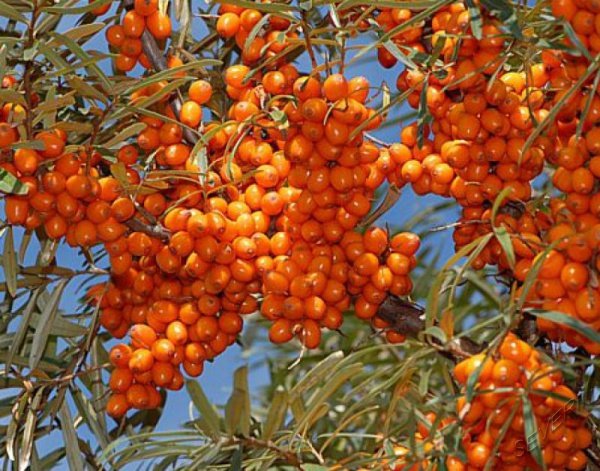

Sea buckthorn Elizaveta was bred in Siberia, but does not differ in particular frost resistance
The average weight of an elongated oval berry is 0.85–1 g. The skin is bright orange, thin. When detached from a branch, it is often damaged. The stalks are long. The berries, which in most varieties of sea buckthorn literally stick to the shoots, are quite loose on the branches of Elizabeth's bushes. The pulp is sweet and sour, very aromatic and juicy. The content of vitamin C is low - 70-80 mg per 100 g.
Winter hardiness up to -20 ° C, yield - 15-18 kg per bush. Fruits are valued for their versatility, they can be eaten fresh. The variety does not have special requirements for the quality of the soil, rarely suffers from diseases and pests.
Galerit
A sea buckthorn variety that forms a very compact bush, moreover, does not differ in its growth rate. The maximum height is up to 1.5 m. The crown is spreading, not thickened. Shoots are thin, curving.
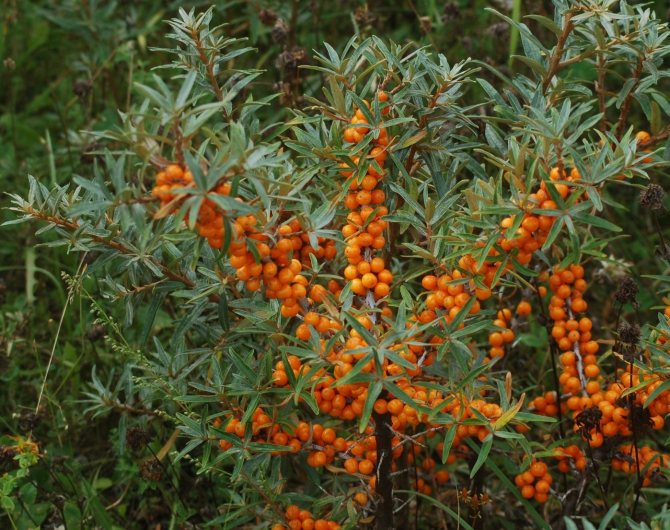

The sea buckthorn bush Galerit is compact, it can be planted even in the smallest garden plots
Berries are elliptical, weighing about 0.8-0.9 g. The skin is shiny, pale orange, covered with spots of reddish-pink "blush", mainly concentrated at the top and base of the fruit. The pulp is very dense, but tender and juicy, with a subtle bitter aftertaste.
The crop ripens late, in the second decade of September. Fruiting is stable, annual. The average yield is 10–12 kg per adult bush.
Essel
One of the latest achievements of breeders. The variety belongs to the category of early, berries ripen in the first decade or closer to mid-August. The plant is tree-like, with a regular oval crown. There are almost no thorns.
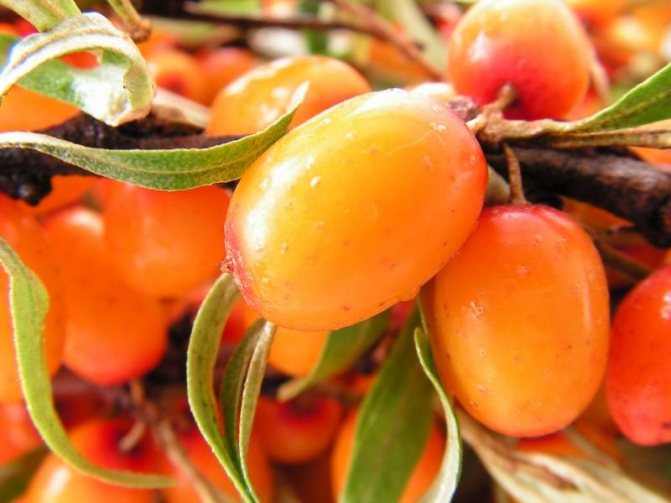

Essel sea buckthorn is one of the latest achievements of breeders
Fruits are large, elongated, in the form of an oval or egg, weighing 1–1.2 g. The skin is pale orange, the flesh is slightly darker. The pulp is very juicy and sweet, the sourness in the taste is almost imperceptible. The fruit separates from the branches extremely easily. Average yield is 10-13 kg.
The variety belongs to the category of dessert, the fruits can be eaten fresh. Fair winter hardiness, up to -25 ° C. Berries work well for juicing.
Lady fingers
Also one of the novelties of the selection. The bush does not differ in size and growth rate. Fruits are elongated, weighing 1–1.3 g. Low yield - 6–7 kg per bush. The taste has earned the highest possible assessment from professional tasters. The variety is dessert, the purpose of the fruit is universal.
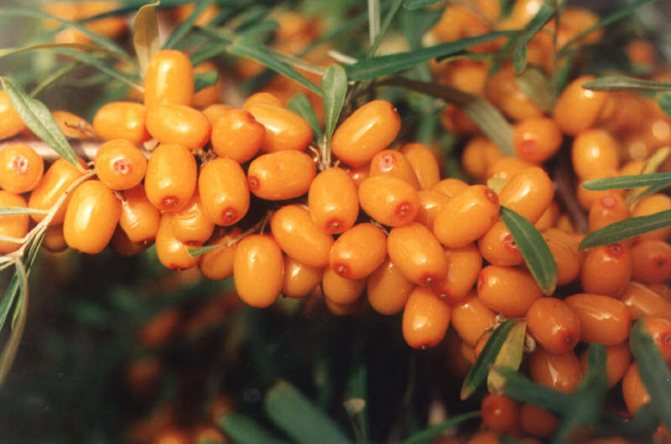

The new variety of sea buckthorn Ladies fingers is still considered the most delicious
Classification of varieties by fruit color
The berries of most varieties of sea buckthorn delight the eye with all shades of orange - from delicate, shimmering golden or linen, to bright, fervently blazing with a reddish "blush". However, there are several options that stand out from the general ranks. Sea buckthorn varieties with red fruits, not to mention the lemon-green Herringbone, will become a true "highlight" of the garden plot, causing surprise and admiration for their unusual appearance.
Orange sea buckthorn varieties
Examples of varieties of sea buckthorn with orange berries are:
| Sea buckthorn variety name | Ripening period | Productivity (kg per bush) | Crown shape | Thorns | Fruit | Resistance of the variety to extreme conditions, pests, diseases |
| Caprice | Middle | 7,2 | Slightly spreading | Average amount | Medium (about 0.7 g), rich orange, sweet with a slight "sourness", aromatic | |
| Turan | Early | About 12 | Medium spreading | Absent | Medium (0.6 g), sweet and sour, dark orange | Frost resistance. It is weakly affected by pests |
| Sayan | Mid-early | 11–16 | Compact | Yes, but not enough | Medium (0.6 g), sweet with "sourness", orange with scarlet "poles" | Winter hardiness. Fusarium resistance |
| Rostov anniversary | Middle | 5,7 | Slightly spreading | Yes, but not enough | Large (0.6-0.9 g), sour with a sweet taste, light orange, refreshing aroma | Increased resistance to drought, cold weather, diseases, pests |
| The lights of the Yenisei | Early | About 8.5 | Medium spreading | Yes, but not enough | Medium (up to 0.6 g), sweet and sour, orange, refreshing aroma | Increased resistance to cold weather. Drought and heat tolerance medium |
| Golden cascade | August 25 - September 10 | 12,8 | Spreading | Absent | Large (about 0.9 g), orange, sweet and sour, refreshing aroma | Winter hardiness. Endomycosis and sea buckthorn fly is weakly affected |
| Ayaganga | Second decade of September | 7-11 kg | Compact, rounded | Average amount | Medium (0.55 g), deep orange | Winter hardiness. Sea buckthorn moth resistance |
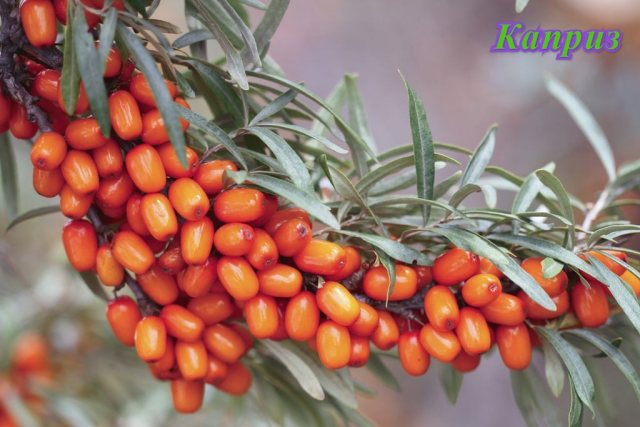

Advice! Bright berries against a background of silvery-green foliage give the sea buckthorn bushes a beautiful decorative look - they can make a magnificent hedge.
Red sea buckthorn
There are few varieties of sea buckthorn with red fruits. The most famous of them:
| Sea buckthorn variety name | Ripening period | Productivity (kg per bush) | Crown shape | Thorns | Fruit | Resistance of the variety to extreme conditions, pests, diseases |
| Red torch | Late | About 6 | Slightly spreading | Single | Large (0.7 g), red with orange tinge, sweet and sour, with aroma | Resistance to frost, disease, pests |
| Krasnoplodnaya | Early | About 13 | Medium spreading, slightly pyramidal | There are | Medium (0.6 g), red, sour, aromatic | Resistance to diseases, pests. Average winter hardiness. |
| Rowan | Middle | Until 6 | Narrow pyramidal | Single | Dark red, shiny, aromatic, bitter | Resistance to fungal diseases |
| Siberian blush | Early | 6 | Highly spreading | Average amount | Medium (0.6 g), red with shine, sour | Winter hardiness. Average resistance to sea buckthorn fly |
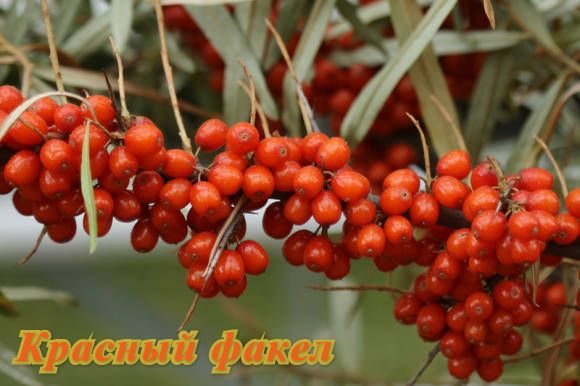

Sea buckthorn with lemon green berries
The beautiful Herringbone, no doubt, will delight those who are interested not only in the harvest, but also in the original, creative design of the site. In this case, it is definitely worth purchasing and planting this rather rare variety. Its bush really resembles a small herringbone: it is about 1.5-1.8 m tall, the crown is compact and dense, has a pyramidal shape. Silvery-green leaves are narrow and long, gathered in whorls at the ends of the branches. The plant has no thorns.
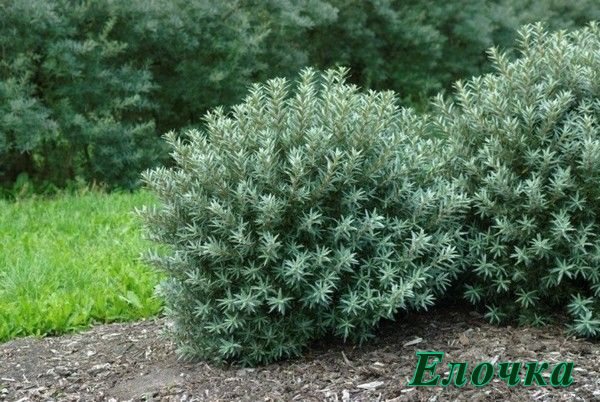

Fir-trees ripen late - at the end of September. Its berries have a unique lemon-green color, but at the same time they are small and very sour in taste.
This variety of sea buckthorn is considered resistant to mycotic wilting, frost and temperature extremes. He practically does not give overgrowth.
A warning! Herringbone is considered an experimental cultivar obtained from seeds that have been exposed to chemical mutagens. It has not yet been entered into the State Register. That is, the resulting form cannot be considered stable - which means that testing and consolidation of characteristic features are still ongoing.
We organize competent care
To grow a healthy, strong tree that brings a rich harvest of medicinal berries, you need to properly care for it. Agrotechnics should include a set of measures aimed at ensuring plant survival after planting and creating favorable conditions for growth.
Watering
High yields of sea buckthorn depend on watering. The culture's demand for moisture increases on the eve of flowering and at the time of the formation and development of fruits. In the dry season, it is necessary to water the shrubs frequently. At the time of harvest, it is recommended to moisturize the plant abundantly and rinse the fruits on the branches.
Water consumption rate for young non-bearing trees 8-12 liters, for fruit-bearing plants 12-15 liters.
Fertilizer
Sea buckthorn does not need fertilization and top dressing, thanks to its long roots it finds food itself. For better growth in the 2nd year after planting in March and in early June, feed with nitrogen substances, applying 15 g of urea or 20 g of ammonium nitrate per 1 m2. In the 3-4th year in the fall, fertilize the plant, taking phosphorus and potassium elements.
Loosening, weeding, mulching
The soil should be loosened carefully to avoid injury to the roots. Damage to the root system will weaken the berry and provoke the appearance of numerous root shoots. Weeds must be removed by mowing them, and not by pulling them out by the roots. Timely mulching will allow you to retain moisture, provide the plant with additional nutrition and prevent pest larvae from emerging from the soil.
Pruning
Caring for sea buckthorn includes pruning the plant at 4-5 years of age. This contributes to the full development of the crown. Before the buds bloom, it is necessary to rid the bushes of damaged branches growing parallel to the trunk, and fruiting shoots, since the large number of berries on the tree will adversely affect its development.
In the fall, carry out sanitary pruning of the plant by removing dry, diseased stems, cleansing from withered leaves and dried berries.
Caring for sea buckthorn, according to many gardeners, is a thankless task. There are too many berries from it, then there are almost no, thorns stick out in all directions, and the taste leaves much to be desired. It turns out that all these unsightly descriptions relate only to the wild sea buckthorn.
It was she who was grown in the USSR, it is she who still flaunts at the "grandmother's" dachas, and it is with her that we have all the most unpleasant and "prickly" memories. Needless to say, berry bushes of modern varieties have a very distant resemblance to their wild predecessor. True, in order to get an excellent harvest, now it is not enough just to stick a branch cut from a neighbor into the ground. Sea buckthorn, although not capricious, requires certain agrotechnical knowledge and skills from the gardener.
Sea buckthorn species
There are only two types of sea buckthorn in the world, but there are countless varieties. In the mountains of Nepal, some provinces of China, as well as Bhutan and India, willow buckthorn is found, and in the territory of other countries, buckthorn is common - we grow it exactly.
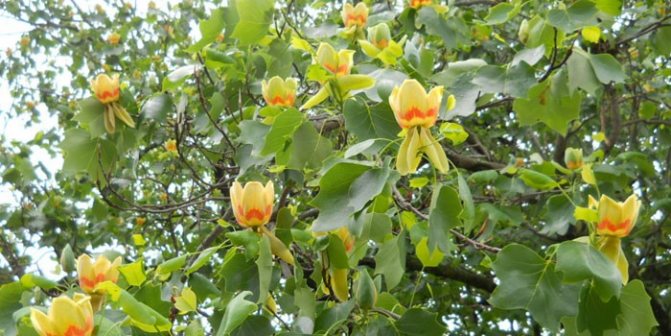

It is not difficult to distinguish a bush, once you see it, you will never forget what a sea buckthorn looks like. Its thin, grayish leaves, nondescript flowers and numerous thorns, of course, cannot be considered beautiful, but branches strewn with golden fruits can become the pride of any garden.
With red fruits
In gardening, the main thing is not always a weighty yield or maximum size. Sometimes you just want to grow something "extraordinary". A tree with shiny scarlet fruits perfectly complements any landscape composition.
Berries of an unusual appearance are characteristic of such varieties:
- Red Torch;
- Rowanberry.
Read more about red sea buckthorn.
Red torch
The fruits of this variety ripen closer to autumn. You can eat berries in any form.
The following features are noted:
- medium-sized shrub;
- rarely on the shoots, but there are thorns;
- small fruits;
- the pulp is sweet and sour;
- amber color;
- rich smell.
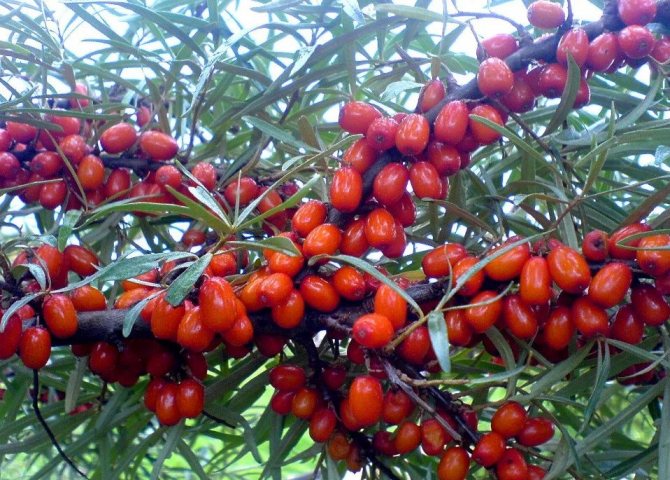

The berries are removed without difficulty, processing occurs without loss of useful properties. You can get sea buckthorn oil, juice, jam, compotes, and also drying.
Important! Sometimes there is an individual intolerance and allergic reactions to sea buckthorn and products prepared on its basis.
Rowan
Rowanberry is an almost two-meter tree.
It is characterized as follows:
- looks like a narrow pyramid;
- minimum of thorns;
- dark burgundy fruit color;
- light bitterness and juiciness of berries;
- to collect it will turn out to be about six kg.
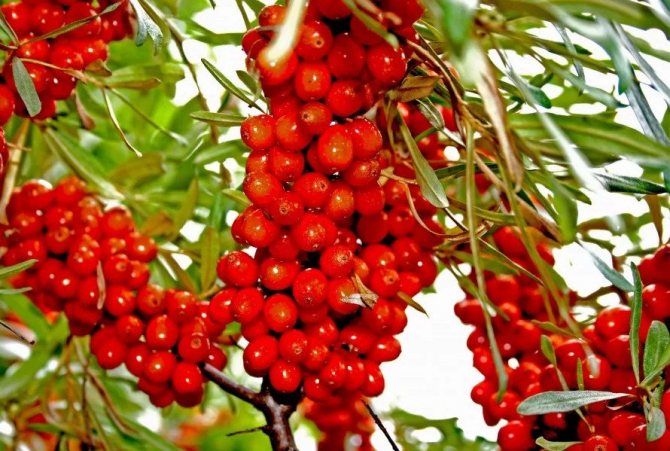

This name of the variety was not chosen by chance - externally and in terms of taste, the fruits are close to mountain ash.

